List of Hypericum species
.jpg)
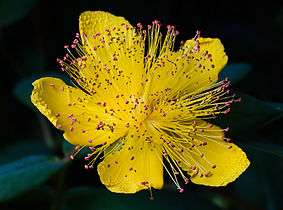
The genus Hypericum contains approximately 500 species which are divided into 36 sections as described by botanist Norman Robson.[1] This division into distinct sections is largely due to the fact that a genus-wide monograph was performed by Robson in 1977, which allowed for a comprehensive breakdown of the genus's taxonomy.[2] A phylogenetic study was more recently completed for the genus, which gave evidence to suggest that the genus Triadenum is a clade within Hypericum and that the genus Thornea is sister to Hypericum. In addition, the study found that about 60% of the sections of Hypericum are monophyletic.[3]
Hypericum species can be found all over the world in temperate to tropical areas. The genus is most populous in China (~60 species) and Eastern Asia, as well as across Central Europe, Anatolia, and the Middle East.[4] The genus has also been introduced into various regions of the United States and Argentina.[5] The genus are generally found in dry, desert areas to being in shallow water, and can be found from warm temperate climates to cold temperate climates.[6]
Almost all species of Hypericum are either perennial herbs, shrubs, or small trees, but the genus also contains a small amount of suffruticose and annual herbs.[2] Most of its species contain hypericin or pseudohypericin and some are used for their healing properties in folk medicine. The species' leaves are always placed opposite, and are normally decussate.[7] Their flowers are generally homostylous, but very few are dimorphically heterostylous. The petals are normally golden yellow or orange, but some are white or cream, and are veined dorsally. They have 4-5 stamen fascicles, 2-5 ovaries, and 2-5 styles. Some species grow capsular fruit which are colored red or blackish.[6]
Some Hypericum species are used as ornamental plants because of their large, spreading flowers.[8] These include H. aegypticum, H. androsaemum, H. calycinum, and H. olympicum. In addition, there are a number of hybrids and cultivars that have been developed for use in horticulture. Some notable cultivars are H. × moserianum, H. 'Hidcote', and H. 'Rowallane'. Several species are also used for their medicinal properties, especially their ability to alleviate mild clinical depression, by drawing out the oily extract from the flowers.[9] H. perforatum is the most potent out of all the species, and is the only species cultivated commercially for herbalism and medicine.[10]
Legend
| Type species[11] | Type species of section |
Type species of genus |
|---|---|---|
| Binomial | The binomial name of the Hypericum species. | |
| Authority | The author's citation of the first person who described the species and/or the person who placed into the genus Hypericum | |
| Type | The type of plant that the species is described as | |
| Habitat | The type of area the species is generally located in | |
| Distribution | The country or region where the species is most densely found | |
| Synonyms | Other names for a species that are generally not accepted by the botanical community | |
Adenosepalum
Adenosepalum Spach is divided into four subsections: Adenosepalum, Aethiopica, Caprifolia, and the Huber-Morathii Group. These subsections contain eight, seven, eleven, and four species, respectively, giving the section Adenosepalum a total of thirty species. In addition, Adenosepalum contains two Nothospecies: H. × joerstadii and H. pubescens × tomentosum. H. annulatum has 3 distinct subspecies.
Description
Adenosepalum is made up of primarily perennial herbs, and also includes shrubs and shrublets. Its species grow to be approximately 2.5 meters tall, and are generally deciduous. Species in Adenosepalum are glabrous or have simple hairs, and almost always have dark black glands on their leaves, sepals, and rarely on their petals and stems. Their leaves are placed opposite and have no ventral glands. Their flowers are stellate or homostylous. They have 5 sepals, 5 stamen fascicles, and 5 petals.[6]
Species
| Binomial | Authority | Type | Habitat | Distribution | Synonyms | Image | References |
|---|---|---|---|---|---|---|---|
| Subsection Adenosepalum | |||||||
| H. annulatum | Moris | Perennial herb | Dry stony places, scrubs or grasslands | Balkans, Saudi Arabia, East Africa | None | [12][13][14][15] | |
| H. athoum | Boiss. & Orph. | Perennial herb | Rock crevices in shade, among limestone | Greece |
|
.jpg) |
[16][12][13][17][18] |
| H. atomarium | Boiss. | Perennial herb | Stony places, near streams, in shade | Greece, Turkey, Portugal (Naturalized) |
|
.jpg) |
[19][20][16][12][21] |
| H. cuisinii | Barbey | Perennial herb | Unknown | Europe |
|
[19][16][12][22] | |
| H. delphicum | Boiss. & Heldr. | Perennial herb | Rocks, in shade and near moisture | Greece | None | .jpg) |
[19][16][12][13][22] |
| H. lanuginosum | Lam. | Perennial herb | Rocks, in shade and near moisture | Middle East, Turkey, Cyprus |
|
[23][1][24][25][26] | |
| H. montanum | L. | Perennial herb | Woods, in thickets on gravelly soil | Scandinavia, Eastern Europe, Iberia, Italy |
|
 |
[19][13][17][27][28] |
| H. reflexum | L.f. | Shrub | Damp walls/cliffs, by springs and streams | Canary Islands |
|
[29][30][31][14][32] | |
| Subsection Aethiopica | |||||||
| H. abilianum | N. Robson | Subshrub | Among grasses and low shrubs | Angola |
|
[5][20][32][33][21] | |
| H. aethiopicum | Thunb. | Perennial herb | Open grasslands, bare areas | Southern Africa | None | [34][32][33][35][36] | |
| H. afrum | Lam. | Perennial herb | Marshes, streamsides, moors | Tunisia, Algeria |
|
.jpg) |
[37][16][30][32][21] |
| H. conjungens | N. Robson | Shrub/subshrub | Grasslands, grassy valleys, forest margins | DRC, Tanzania, Malawi, Zambia |
|
.jpg) |
[23][32][21][38][39] |
| H. glandulosum | Aiton | Shrub | Open rocky hillsides, among thickets | Canary Islands, Madeira |
|
 |
[29][40][22][41] |
| H. kiboënse | Oliv. | Shrub/Subshrub | Upland grasslands, along streams | Uganda, Kenya, Tanzania |
|
[42][43][22] | |
| Subsection Caprifolia | |||||||
| H. caprifolium | Boiss. | Perennial herb | Streamsides, flushes, shady places | Spain |
|
.jpg) |
[19][16][12][14][32] |
| H. coadunatum | Chr. Sm. | Subshrub/Perennial herb | Wet rocks | Canary Islands | None | .jpg) |
[29][30][14][32][41] |
| H. collenettiae | N. Robson | Subshrub/Perennial herb | Shady rock crevices | Saudi Arabia |
|
.jpg) |
[23][1][21][22] |
| H. naudinianum | Coss. & Durieu | Perennial herb | Wet rocks, banks, waterfalls | Morocco, Algeria |
|
[42][32][40][22] | |
| H. psilophytum | (Diels) Maire | Perennial herb | Damp wadis margins | Morocco, Algeria | None | [5][30][32][22] | |
| H. pubescens | Boiss. | Perennial herb | Damp ground, roadsides, waste habitats | Southern Iberia, North Africa |
|
[19][20][44][32][40] | |
| H. scruglii | Bacch., Brullo & Salmeri | Unknown | Unknown | Unknown | None | [42][22][45] | |
| H. sinaicum | Hochst. ex Boiss. | Perennial herb | Seepage areas, damp rocks | Egypt, Arabian Peninsula |
|
[42][30][26][22][46] | |
| H. somaliense | N. Robson | Perennial herb | Streamsides, in clay | Somalia | None | [5][32][22] | |
| H. tomentosum | L. | Perennial herb | Marshy grasslands, stream margins | Iberia, France, North Africa, Sardinia, Italy |
|
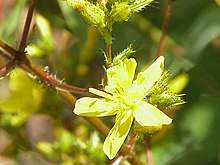 |
[19][47][30][31][14] |
| Huber-Morathii Group | |||||||
| H. decaisneanum | Coss. & Daveau | Perennial herb | In limestone rocks | Libya |
|
[42][16][30][32][22] | |
| H. formosissimum | Takht. | Perennial herb | In limestone rocks | Armenia, Azerbaijan, Turkey |
|
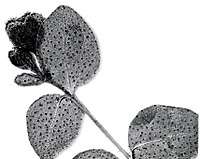 |
[23][20][24][22] |
| H. huber-morathii | N. Robson | Perennial herb | In limestone rocks | Turkey | None | [48][49][30][22] | |
| H. minutum | P.H.Davis & Poulter | Perennial herb | In limestone rocks | Turkey | None | [5][1][24][22] | |
| H. sechmenii | Ocak & O.Koyuncu | Perennial herb | In limestone rocks, hilly screes, steppe | Turkey | None | [50][22][51][23] | |
Nothospecies
| Binomial | Authority | Type | Habitat | Distribution | Parentage | Synonyms | Image | References |
|---|---|---|---|---|---|---|---|---|
| H. × joerstadii | Lid | Intermediate shrub | In cultivation only | Canary Islands | None | .jpg) |
[5][46][52][42][53] | |
| H. pubescens × tomentosum | Unknown | Unknown | In cultivation only | Spain, Morocco, Algeria |
|
[6][54][55] |
Adenotrias
Adenotrias (Jaub. & Spach) R. Keller contains three species: H. aciferum, H. aegypticum, and H. russeggeri. Its type species is H. russeggeri. It is not divided into any subsections. H. aegypticum has three subspecies: H. aegypticum aegypticum L., H. aegypticum maroccanum (Pau) N. Robson, and H. aegypticum webbii (Spach) N. Robson.[53]
Description
Adenotrias contains shrubs and shrublets. Its species can grow to be up to 2 meters tall. Its species are glabrous, but have no dark glands. Their leaves are lined and glandular, and are cortex green. Their flowers are almost tubular, and are heterostylous. They have 5 sepals, 5 petals, and 3 stamen fascicles.[6]
Species
| Binomial | Authority | Type | Habitat | Distribution | Synonyms | Image | References |
|---|---|---|---|---|---|---|---|
| H. aciferum | (Greuter) N. Robson | Shrublet | Among rocks | Crete |
|
[5][46][19][16][12] | |
| H. aegypticum | L. | Shrub/shrublet | Among limestone rocks, along coasts | North Africa, Greece, Sardinia |
|
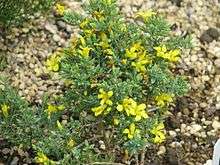 |
[56][44][57][58][59] |
| H. russeggeri | (Fenzl) R. Keller | Shrub/shrublet | Among rocks | Turkey, Syria |
|
[46][42][30][24] |
Androsaemum
Androsaemum (Duhamel) Godron contains four species: H. androsaemum, H. foliosum, H. grandifolium, and H. hircinum. In addition, Androsaemum contains one Nothospecies: H. × inodorum. It is not divided into subsections. Its type species is H. androsaemum. One of its species, H. grandifolium, has five different subspecies. The section's species are often collectively referred to as Tutsan.
Description
Androsaemum contains shrubs that grow to be from 0.3-2 meters tall. Its species are deciduous and glabrous, but have no dark glands. Their leaves are opposite, decussate, free, and are a pale color. Every species has 20 flowers, branching out from 2 separate nodes, which are homostylous. They have 5 sepals, 5 petals, and 5 stamen fascicles.[6]
Species
| Binomial | Authority | Type | Habitat | Distribution | Synonyms | Image | References |
|---|---|---|---|---|---|---|---|
| H. androsaemum | L. | Shrub | Open woodlands | Southern Europe, North Africa |
|
 |
[60][61][62][63][59] |
| H. foliosum | Aiton | Shrub | Damp shade in mountainous regions | Portugal (The Azores) |
|
[37][47][42][19][40] | |
| H. grandifolium | Choisy | Shrub | Evergreen forests | Spain (Canary Islands), Portugal (Madeira) |
|
 |
[61][64][65][66][67] |
| H. hircinum | L. | Shrub | Damp shade by streams | France, Iberia, Italy, Middle East, North Africa |
|
[68][65][25][26][69] |
Nothospecies
| Binomial | Authority | Type | Habitat | Distribution | Synonyms | Image | References |
|---|---|---|---|---|---|---|---|
| H. × inodorum | Mill. | Deciduous shrub | Bushy areas | Corsica, France, Italy, Spain |
|
[46][70][71][56][65] |
Arthrophyllum
Arthrophyllum Jaub. & Spach contains five species, and is not divided into any subsections. Its type species is H. rupestre. Arthrophyllum is most closely related to Webbia.[72]
Description
Arthrophyllum contains shrubs that grow to be approximately 0.9 meters tall and are deciduous but never leafless. Species in Arthrophyllum are glabrous, with reddish to dark glands. Their leaves are placed opposite and are either decussate, sessile, free, or perfoliate and have no ventral glands. They are 40-flowered, and their flowers are stellate and homostylous. They have 5 sepals that lack marginal glands. Arthrophyllum's species also have 5 petals and 3 stamen fascicles, each with 20-40 stamens. Their seeds are narrow and cylindrical.[6]
Species
| Binomial | Authority | Type | Habitat | Distribution | Synonyms | Image | References |
|---|---|---|---|---|---|---|---|
| H. cardiophyllum | Boiss. | Shrub | Calcareous rocks | Turkey, Syria | None | 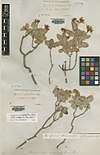 |
[73][46][16][24][21] |
| H. nanum | Poir. | Shrub | Calcareous rocks | Lebanon, Syria | None | 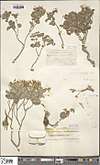 |
[73][46][24][26][40] |
| H. pamphylicum | N. Robson & P.H.Davis | Shrub | Limestone rocks | Turkey | None | 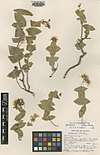 |
[46][42][16][24][22] |
| H. rupestre | Jaub. & Spach | Shrub | Limestone cliffs | Turkey |
|
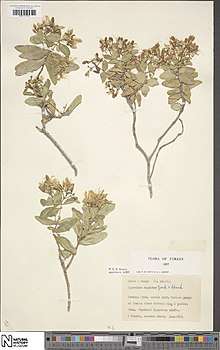 |
[46][48][30][24][32] |
| H. vacciniifolium | Hayek & Siehe | Shrub | Limestone cliffs | Turkey |
|
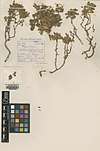 |
[46][20][24][17][22] |
Ascyreia
Ascyreia Choisy contains exactly 50 species and also includes 4 Nothospecies. The section is one of the largest in the genus that is not divided into any subsections. Its type species is H. calycinum. The section is synonymous with Norysca Spach..[4]
Description
Ascyreia is made up of mostly shrubs or shrublets, but also contains a few trees. Its species generally grow to be from 4-5 meters tall. Some of the species are evergreen, but most are deciduous. They are glabrous, and lack dark glands. Their leaves are opposite, decussate, and free. The section's species have anywhere from 1-25 flowers, which are stellate and homostylous. They have 5 sepals, which are free. They also have 5 petals and 5 stamen fascicles, which each have 20-100 stamens. Their seeds are cylindric or ellipsoid, and some are laterally winged.[6]
Species
| Binomial | Authority | Type | Habitat | Distribution | Synonyms | Image | References |
|---|---|---|---|---|---|---|---|
| H. acmosepalum | N. Robson | Shrub | Forest glades, stream-sides | China |
|
[13][65][21][74][4] | |
| H. addingtonii | N. Robson | Shrub | Unknown | China |
|
[56][13][65][75][74] | |
| H. augustinii | N. Robson | Shrub | Unknown | China | None |  |
[13][65][21][74][4] |
| H. beanii | N. Robson | Shrub | Open forests, thickets | China |
|
[70][76][31][14][77] | |
| H. bellum | H.L.Li | Shrub | Dry slopes, by streams | China | None | [62][13][60][78][65] | |
| H. calycinum | L. | Shrub | Shady woods, shady banks | Bulgaria, Turkey |
|
 |
[56][62][79][60][63] |
| H. choisianum | Wall. ex N. Robson | Shrub | Grassy or rocky cliffs | China, India, Pakistan |
|
[80][62][13][65][74] | |
| H. cohaerens | N. Robson | Shrub | Thickets, rocky slopes | China | [74][4][22] | ||
| H. cordifolium | Choisy | Shrub | Steep banks, rocky hillsides | Nepal |
|
[62][1][65][21][40] | |
| H. curvisepalum | N. Robson | Shrub | Dry/rocky hillsides, open woods | China | [13][74][4] | ||
| H. elatoides | R.Keller | Suffrutex | Damp open grasslands | China |
|
[68][74][4] | |
| H. forrestii | (Chitt.) N. Robson | Shrub | Stony hillsides, by streams | China, Burma |
|
[80][13][78][81][77] | |
| H. gaitii | Haines | Shrub | Shady cliffs, along streams | India | [48][82][62] | ||
| H. gracilipes | Stapf ex C.E.C.Fisch. | Shrub | Shaded streamsides | India, Bangladesh | [5][22] | ||
| H. griffithii | Hook.f. & Thomson ex Dyer | Shrub | Dry hillsides, river banks | Bhutan, India | [83][84][62][4] | ||
| H. henryi | H.Lév. & Vaniot | Shrub | Dry, open areas | China, Southeast Asia |
|
[56][74][4][22] | |
| H. hookerianum | Wight & Arn. | Shrub | Open habitats | East and South Asia |
|
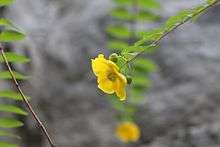 |
[76][62][61][13][40] |
| H. kouytchense | H.Lév. | Shrub | Pastures, open hillsides | China |
|
.jpg) |
[56][60][63][74][85] |
| H. lacei | N. Robson | Shrub | Myanmar | [48][20][22] | |||
| H. lagarocladum | N. Robson | Shrub | Roadsides, grassy slopes | China |
|
[1][74][4][22] | |
| H. lancasteri | N. Robson | Shrub | Dry grassy banks and slopes | China | None | 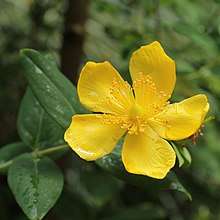 |
[13][74][4][22] |
| H. leschenaultii | Choisy | Shrub/small tree | Slopes, thickets, woodlands | Indonesia |
|
[42][65][14][40][86] | |
| H. lobbii | N. Robson | Shrub | India | [5][65][22] | |||
| H. maclarenii | N. Robson | Shrub | Rocky banks | China |
|
[13][74][4][22] | |
| H. monogynum | L. | Shrub | Cliffs, hills, roadsides | China (Southeast), Taiwan |
|
 |
[62][78][65][74][15] |
| H. mysurense | Wall. ex Wight & Arn. | Shrub | Thickets, open hillsides | India (South), Sri Lanka |
|
.jpg) |
[62][1][43][22] |
| H. oblongifolium | Choisy | Shrub | Damp crevices, thickets | Pakistan, India, Nepal |
|
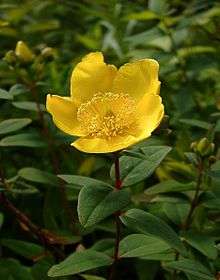 |
[80][62][13][14][40] |
| H. pachyphyllum | Collett & Hemsl. | Shrub/undershrub | Open slopes, thickets | Myanmar |
|
[48][40][22] | |
| H. patulum | Thunb. | Shrub | Dry, open areas | China |
|
[47][31][87][60][78] | |
| H. podocarpoides | N. Robson | Shrub | Grassy slopes, rock faces | Nepal, India |
|
[62][22] | |
| H. prattii | Hemsl. | Shrub | Glens | China | [74][4][22] | ||
| H. pseudohenryi | N. Robson | Shrub | Pine forests, thickets, dry slopes | China |
|
 |
[47][81][88][89][28] |
| H. reptans | Hook.f. & Thomson ex Dyer | Shrublet | Slopes, cliffs, marshes | China, Burma, India, Nepal | .jpg) |
[62][65][17][74][4] | |
| H. sherriffii | N. Robson & D.G.Long | Shrub | Cliffs, steep slopes | Bhutan | [37][20][22] | ||
| H. siamense | N. Robson | Shrub | Open evergreen forests | Thailand |
|
[42][1][22] | |
| H. stellatum | N. Robson | Shrub | Thickets, slopes | China |
|
[62][65][74][4][22] | |
| H. subsessile | N. Robson | Shrub | Thickets | China | [13][65][74][4][22] | ||
| H. tenuicaule | Hook.f. & Thomson ex Dyer | Shrub | Rocky banks under trees | Bhutan, India, Nepal |
|
[48][62][22] | |
| H. uralum | Buch.-Ham. ex D.Don | Shrub | Dry open areas, in thickets, by streams | China, Burma, India |
|
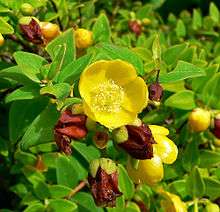 |
[76][62][89][74][90] |
| H. wardianum | N. Robson | Shrub | Hillsides, cliffs, forest clearings | China, Burma | [20][74][4][22] | ||
| H. williamsii | N. Robson | Shrub | Rocky/grassy slopes, in shade | Nepal | [42][62][22] | ||
| H. wilsonii | N. Robson | Shrub | Cliffs, thickets | China |
|
[1][65][14][74][4] |
Nothospecies
| Binomial | Authority | Type | Habitat | Distribution | Parentage | Synonyms | Image | References |
|---|---|---|---|---|---|---|---|---|
| H. kouytchense × calycinum | (D.Walker) | Shrub | Only in cultivation | Only in cultivation | None | [5][1] | ||
| H. × cyathiflorum | N. Robson | Shrub | Only in cultivation | Only in cultivation | H. addingtonii × H. hookerianum | None | .jpg) |
[42][1][65][55] |
| H. × dummeri | N. Robson | Shrub | Only in cultivation | Only in cultivation | H. calycinum L. × H. forrestii (Chitt.) N.Robson | None | .jpg) |
[42][13][55] |
| H. × moserianum | André | Shrub | Only in cultivation | Only in cultivation | None | _H._x_moserianum-2.jpg) |
[70][76][13][56][65] |
Brathys
Brathys (Mutis ex L.f.) Choisy is the largest section in Hypericum. It is divided into four subsections: Brathys, Phellotes, Spachium, and Styphelioides. Brathys contains 38 species and the type species, H. juniperinum. Phellotes contains 32 species, Spachium contains 14 species, and Styphelioides contains just 2 species. In total, the section contains 86 species.
Description
Brathys contains a wide variety of plants, including small trees, shrubs, shrublets, and herbs. The largest species in the section grow to be 6 meters tall, and are evergreen. Its species are glabrous- though a few have simple hairs- and lack any dark glands. Their stems are either 4 or 6-lined, and are compressed when the plant is young, but later become terete. Their leaves are placed opposite, are decussate and sessile, and have dense marginal glands. All the species have either one flower on the uppermost node of the plant or 2-15 flowers branching from the uppermost node and from lower secondary nodes. The flowers are stellate or sometimes obconic, and are homostylous. The species have 5 petals which are persistent. They have 5 stamen fascicles which contain anywhere from 1-50 stamens each, formed in a tight ring, to give the plants a total of anywhere from 5-250 stamens. The plants have 5 ovaries, 5 sepals, and 3-5 styles.[6]
Species
| Binomial | Authority | Type | Habitat | Distribution | Synonyms | Image | References |
|---|---|---|---|---|---|---|---|
| Subsection Brathys | |||||||
| H. aciculare | Kunth | Shrub | Dry, open slopes/paramo | Peru, Ecuador |
|
[5][91][87][21][22] | |
| H. andinum | Gleason | Shrub/shrublet | Open/Grassy slopes, bogs |
|
[42][31][91][21][92] | ||
| H. baccharoides | Cuatrec. | Shrub | Forests, paramo | Colombia, Venezuela | None | [20][21][22] | |
| H. bolivaricum | N. Robson | Shrub | Colombia | [91][21][22] | |||
| H. bryoides | Gleason | Suffrutex | Rocky places, open paramo | Colombia | [1][21][22] | ||
| H. caracasanum | Willd. | Shrub/shrublet | Shaded places in paramo and subparamo | Venezuela | [21][22] | ||
| H. cardonae | Cuatrec. | Shrub/shrublet | Humid places in paramo | Costa Rica, Venezuela, Colombia |
|
[20][21][22] | |
| H. cassiopiforme | N. Robson | Shrub | Jalca zone | Peru | [1][21] | ||
| H. costaricense | N. Robson | Shrub/shrublet | Open paramo, rocky and volcanic slopes | Colombia, Costa Rica |
|
 |
[23][21] |
| H. decandrum | Turcz. | Shrub/shrublet | Grassy or shrubby paramo | Ecuador, Peru |
|
[87] | |
| H. harlingii | N. Robson | Shrub | Montane forest | Ecuador | None | [87] | |
| H. horizontale | N. Robson | Shrublet | Dry open sandy areas | Colombia | None | [22] | |
| H. jaramilloi | N. Robson | Shrub | Paramo | Costa Rica, Colombia | None | ||
| H. juniperinum | Kunth | Shrub/shrublet | Open forests, forest margins, shaded paramo | Colombia, Venezuela |
|
.jpg) |
[23] |
| H. lancifolium | Gleason | Shrub | Paramo | Colombia, Venezuela |
|
[1] | |
| H. lancioides | Cuatrec. | Shrub | Damp sheltered areas of the paramo | Colombia, Ecuador, Venezuela | None | [5][91][87] | |
| H. llanganaticum | N. Robson | Shrub | Grassy paramo, reed forest | Ecuador | None | [37][5][87] | |
| H. magdalenicum | N. Robson | Shrub/small tree | Paramo forest, scrub, damp grassland | Colombia, Venezuela | None | [42] | |
| H. magniflorum | Cuatrec. | Shrub | Rocky slopes of limestone outcrops | Colombia, Venezuela | None | [20] | |
| H. marahuacanum | N. Robson | Shrub | Shaded streams, swampy areas, on escarpment | Colombia, Venezuela | None | ||
| H. mexicanum | L. | Shrub/shrublet | Open paramo, grassy slopes, in shrub | Colombia, Venezuela |
|
[23][40] | |
| H. millefolium | Urb. & Ekman | Shrub | Among limestone rocks | Haiti | None | ||
| H. parallelum | N. Robson | Shrub | Paramo | Colombia | None | ||
| H. pimeleoides | Planch. & Linden ex Triana & Planch. | Shrub | Open paramo | Colombia |
|
[1] | |
| H. prietoi | N. Robson | Shrub | On crests of cordillera | Ecuador | None | [37][87] | |
| H. prostratum | Cuatrec. | Shrub/Shrublet | Open paramo, in damp areas | Colombia | None | [20] | |
| H. pycnophyllum | Urb. | Shrub | In open forests, among rocks at high altitudes | Dominican Republic | None | ||
| H. recurvum | N. Robson | Shrub | Open hillsides, exposed boggy areas | Peru | None | [91] | |
| H. ruscoides | Cuatrec. | Shrub | Paramo | Colombia, Ecuador | None | [47][87] | |
| H. selaginella | N. Robson | Shrublet | Dry or stony damp paramo/superparamo | Colombia |
|
[5] | |
| H. sprucei | N. Robson | Shrub | Open dry damp paramo | Ecuador |
|
[42][91][87] | |
| H. strictum | Kunth | Shrub | Dry rocky paramo/subparamo, open grassland | Colombia |
|
[93][47][87] | |
| H. struthiolifolium | Juss. | Shrub | Open hillsides among shrub | Peru |
|
[23][47][91][40] | |
| H. stuebelii | Hieron. | Shrub | Unknown | South America | None | [1] | |
| H. tetrastichum | Cuatrec. | Shrub/shrublet | Wet exposed areas in paramo/subparamo | Colombia | None | [5][47] | |
| H. valleanum | N. Robson | Shrub | Paramo | Colombia | None | [20] | |
| H. wurdackii | N. Robson | Shrub | Unknown | Peru | None | ||
| Subsection Phellotes | |||||||
| H. acostanum | Steyerm. ex N. Robson | Shrub | Shrubby slopes | Ecuador |
|
[5][37][87][21] | |
| H. asplundii | N. Robson | Shrublet | Thicket edges | Ecuador | [37][87][21] | ||
| H. callacallanum | N. Robson | Shrub | Open areas | Peru | [37][21] | ||
| H. carinosum | R. Keller | Shrub | Thickets and woodlands in paramo | Colombia, Venezuela |
|
[23][21] | |
| H. castellanoi | N. Robson | Shrub/shrublet | Open places among shrubs | Colombia, Venezuela | [1][21] | ||
| H. cuatrecasii | Gleason | Shrub | Paramo, degraded forests | Colombia | None | ||
| H. espinalii | N. Robson | Shrub | Unknown | Colombia | None | ||
| H. garciae | Pierce | Shrub | Paramo, on sandy soil | Colombia, Venezuela |
|
[5] | |
| H. gladiatum | N. Robson | Shrub | Unknown | Colombia | None | ||
| H. goyanesii | Cuatrec. | Shrub | Paramo/subparamo, degraded forests, near water | Colombia | None | [1] | |
| H. hartwegii | Benth. | Shrub | Unknown | Ecuador | None | [37][87] | |
| H. humboldtianum | Steud. | Shrub/shrublet | Thickets, open slopes of paramo | Colombia, Venezuela |
|
[42][40] | |
| H. irazuense | Kuntze ex N. Robson | Shrub/small tree | Open paramo slopes, among bamboo | Costa Rica, Panama |
|
 |
[23][94] |
| H. laricifolium | Juss. | Shrub/small tree | Paramo/subparamo | Colombia, Ecuador, Peru, Venezuela |
|
.jpg) |
[5][91][87][40][95] |
| H. loxense | Benth. | Shrub/shrublet | Dry slopes and rocky areas of the paramo | Ecuador, Peru | None | [20][91][87] | |
| H. lycopodioides | Triana & Planch. | Shrub | Thickets in paramo/subparamo | Colombia |
|
||
| H. maguirei | N. Robson | Shrub | Dry slopes and grasslands, among low shrubs | Ecuador | None | [37][87] | |
| H. martense | N. Robson | Shrublet | Rocky paramo, muddy areas | Colombia | None | [31] | |
| H. matangense | N. Robson | Shrub | Scrub paramo | Ecuador | None | [37][87] | |
| H. myricariifolium | Hieron. | Shrub | Open slopes in paramo | Colombia |
|
.jpg) |
[5] |
| H. papillosum | N. Robson | Shrub | Dry rock slopes in paramo/subparamo | Colombia | None | [20] | |
| H. paramitanum | N. Robson | Shrub/small tree | Paramo/subparamo | Venezuela | None | [1] | |
| H. phellos | Gleason | Shrub/small tree | Scrubby slopes, moist woods | Colombia, Venezuela |
|
[5] | |
| H. piriai | Arechav. | Shrub/perennial herb | Stony or damp grassland, lowlands | Brazil, Uruguay |
|
[42][22] | |
| H. quitense | R.Keller | Shrub/shrublet | Damp meadows of paramo | Ecuador |
|
[37][47][87] | |
| H. radicans | N. Robson | Shrublet | Muddy areas | Colombia | None | [20] | |
| H. roraimense | Gleason | Shrub | Swampy areas | Venezuela | None | [94] | |
| H. sabiniforme | Trevis. | Shrub | Dry paramo | Colombia |
|
[23] | |
| H. simonsii | N. Robson | Shrub (?) | Paramo, bushy prairies, thickets | Colombia |
|
[1] | |
| H. stenopetalum | Turcz. | Shrub/small tree | Scrubby or stony paramo slopes | Colombia, Venezuela |
|
[47][94] | |
| H. thuyoides | Kunth | Shrub/small tree | Scrub and thickets on paramo slopes, in boggy areas | Colombia | None | [47][40] | |
| H. woodianum | N. Robson | Shrub | Roadside banks near forests | Colombia | None | [5] | |
| Subsection Spachium | |||||||
| H. arbuscula | Standl. & Steyerm. | Subshrub/shrublet | Unknown | Mexico, Guatemala |
|
[20][31][21] | |
| H. beamanii | N. Robson | Shrublet | Depressions by fumerole vents | Guatemala | None | [21] | |
| H. chamaemyrtus | Triana & Planch. | Subshrub | Paramo, dense woods and meadows | Colombia, Venezuela | None | [1][21] | |
| H. cymobrathys | N. Robson | Shrub | Shrubby woodlands, dry slopes | Colombia | None | ||
| H. dichotomum | Lam. | Perennial herb | Open wet roadsides, forests | Dominican Republic, Haiti |
|
[96][95] | |
| H. diosmoides | Griseb. | Perennial herb | Open shaded grassy slopes, roadsides, damp areas | Dominican Republic, Haiti, Puerto Rico, Cuba |
|
[70][31][40][97] | |
| H. drummondii | (Grev. & Hook.) Torr. & A. Gray | Annual herb | Open woods, old fields, rocky places | United States |
|
[70][98][99][100][101] | |
| H. eastwoodianum | I.M.Johnst. | Subshrub/shrublet | Sheltered places in dry rocks | Mexico |
|
[23][31] | |
| H. fuertesii | Urb. | Shrublet/perennial herb | Grassy slopes, open | Dominican Republic, Haiti | None | [20] | |
| H. galinum | S.F. Blake | Shrublet | Dry rocky calcareous areas | Mexico |
|
[5] | |
| H. gentianoides | (L.) Britton, Sterns & Poggenb. | Annual herb | Sandy areas in open fields, roadsides, rocky areas | Canada, United States, Dominican Republic, Paraguay, Brazil |
|
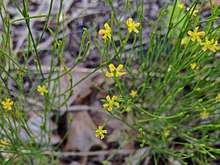 |
[102][103][99][101][28] |
| H. gnidioides | Seem. | Subshrub/shrublet | Open places in dry forests, paramo, dry grasslands | Costa Rica, Honduras, Panama |
|
[20][91][40][94] | |
| H. peninsulare | Eastw. | Subshrub/perennial herb | Sheltered dry areas, meadows, among rocks | Mexico |
|
[42][31] | |
| H. rubritinctum | N. Robson | Shrublet | Rocky woodlands, rocky forests | Mexico |
|
[47][31] | |
| Subsection Styphelioides | |||||||
| H. styphelioides | A.Rich. | Shrub | Pine forests and savannah, around lakes and pools | Cuba | None | [23][47][91] | |
| H. terrae-firmae | Sprague & L.Riley | Shrub/small tree | Open pine, near streams | Belize |
|
[5][47][31][94] | |
Bupleuroides
Bupleuroides Stef. contains one species, H. bupleuroides, which shares the name of the section.
Description
H. bupleuroides is a perennial herb that grows to be approximately 75 centimeters tall. The species' stems sprout from branching rhizomes, and are glabrous and lack dark glands. The leaves are placed opposite and are terete and are perfoliate. It has anywhere from 4-25 flowers that branch from 1-5 nodes and are stellate and homostylous and have 5 petals. There are either 3 or 4 stamen fascicles with 20-25 stamens each. The species has 5 sepals, 3 ovaries, and 3 styles.[6]
Species
| Binomial | Authority | Type | Habitat | Distribution | Synonyms | Image | References |
|---|---|---|---|---|---|---|---|
| H. bupleuroides | Stef. | Perennial herb | Mountain woods, damp valleys, wooded slopes | Turkey, Russia |
|
[89][48][42][16][104] |
Campylopus
Campylopus Boiss. contains one species, H. cerastioides, which is also frequently called H. campylopus. This species is widely cultivated for its vibrant flowers. The section is most closely related to Olympia and Oligostema.[104]
Species
| Binomial | Authority | Type | Habitat | Distribution | Synonyms | Image | References |
|---|---|---|---|---|---|---|---|
| H. cerastioides | N. Robson | Suffrutex/Perennial herb | Meadows, among rocks | Bulgaria, Greece, Turkey |
|
 |
[76][12][65][89][104] |
Camplyosporus
Campylosporus (Spach) R. Keller contains 10 species from Africa and the Middle East. Its type species is H. lanceolatum.
Description
The section contains primarily shrubs and trees that can be spreading or grow up to 12 meters tall. They are all evergreen and may or may not have dark glands along the branches. Most species have bark which is fissured and scaly. The species have many flowers which are homostylous. They have 5 sepals, 5 petals, and 5 stamen fascicles which each have 20-45 stamens.[6]
Species
| Binomial | Authority | Type | Habitat | Distribution | Synonyms | Image | References |
|---|---|---|---|---|---|---|---|
| H. balfourii | N. Robson | Shrub/tree | Granite slopes, rock crevices | Socotra |
|
[37][21][94] | |
| H. bequaertii | De Wild. | Shrub/tree | Open forest, thickets | Unknown |
|
[42][13][32][21] | |
| H. gnidiifolium | A.Rich. | Shrub/tree | Streambanks | Ethiopia |
|
[37][15] | |
| H. lanceolatum | Lam. | Shrub/small tree | Forests, forest clearings, savannahs, grasslands | Comoros, Réunion | None | [42][14][15][94] | |
| H. madagascariense | (Spach) Steud. | Shrub | Clearings, damp depressions, montane forests | Madagascar |
|
[23] | |
| H. quartinianum | A.Rich. | Shrub/tree | Rocky places, gulleys, river banks, upland grasslands | Yemen, Ethiopia, Kenya, Uganda, Tanzania, Malawi, Zambia, Mozambique |
|
[31][32][33][38][15] | |
| H. revolutum | Vahl | Shrub/tree | Open forests, forest margins, savannas, grasslands | Middle East, Ethiopia, Cameroon |
|
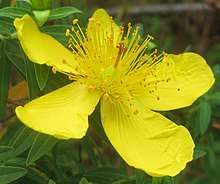 |
[13][65][32][39][15] |
| H. roeperianum | Schimp. ex A.Rich. | Shrub/tree | Evergreen forest margins, bushland/grassland, by rivers | Ethiopia, Zambia, Angola, Guinea, Nigeria, Cameroon |
|
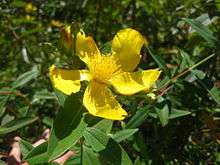 |
[76][35][32][33][15] |
| H. socotranum | R.D.Good | Shrub (?) | Unknown | Socotra |
|
[37][47] | |
| H. synstylum | N. Robson | Shrub | Among limestone rocks, on black soil | Ethiopia, Somalia | None | [42][32] |
Concinna
Concinna N. Robson contains one species, H. concinnum, which is commonly known as Goldwire.
Species
| Binomial | Authority | Type | Habitat | Distribution | Synonyms | Image | References |
|---|---|---|---|---|---|---|---|
| H. concinnum | Benth. | Perennial herb/suffruticose | Dry slopes, forests | United States (California, Nevada) |
|
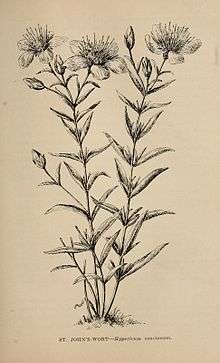 |
[80][61][105][99][100] |
Coridium
Species
| Binomial | Authority | Type | Habitat | Distribution | Synonyms | Image | References |
|---|---|---|---|---|---|---|---|
| H. amblycalyx | Coustur. & Gand. | Dwarf shrub | Limestone cliffs | Crete (Eastern) |
|
[42][19][16][12][69] | |
| H. asperuloides | Czern. ex Turcz. | Perennial herb | Calcerous rocks, open glades, dry grassy areas | Russia |
|
[42] | |
| H. coris | L. | Low shrub | Calcerous rocks | Switzerland, France (Southeastern), Italy (Northern) |
|
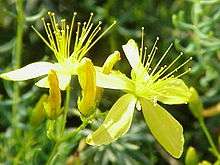 |
[70][76][12][65][89] |
| H. empetrifolium | Willd. | Subshrub | Woods, dry rocky slopes | Albania, Greece, Turkey (Western), Libya |
|
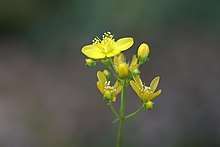 |
[13][65][25][59][69] |
| H. ericoides | L. | Dwarf shrub | Fissures of limestone/dolomitic rocks | Spain, Tunisia, Morocco |
|
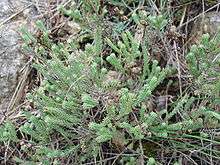 |
[48][19][12][13][17] |
| H. jovis | Greuter | Dwarf shrub | Limestone cliffs | Crete (Central) | [48][69] |
Crossophyllum
Crossophyllum Spach contains 4 species of perennial herbs. Its type species is H. orientale. The other species in the section are H. adenotrichum, H. aucheri, and H. thasium.
Description
Species in Crossophyllum grow to be around 55 centimeters tall. They are glabrous, and their stems are erect from a rooting base. Their flowers also branch from the base and sometimes from intermediate nodes. The species have anywhere from 1 to 50 flowers which are stellate and homostylous. Their stems are narrow and eglandular and have dark black or amber glands on raised lines. The leaves are placed opposite and are free and decussate. The species have 5 sepals, 5 petals, and 3 or 5 stamen fascicles with 10-20 stamens each.[6]
Species
| Binomial | Authority | Type | Habitat | Distribution | Synonyms | Image | References |
|---|---|---|---|---|---|---|---|
| H. adenotrichum | Spach | Perennial herb | Woodland areas, humid habitats | Turkey |
|
[46][16][30][21][28] | |
| H. aucheri | Jaub. & Spach | Perennial herb | Stony/sandy open areas, on calcareous ground, on siliceous soil | Bulgaria, Greece, Turkey |
|
[46][19][16][12][21] | |
| H. orientale | L. | Perennial herb | Igneous stony slopes, woodlands | Georgia, Turkey, Russia |
|
 |
[48][42][13][89][104] |
| H. thasium | Griseb. | Perennial herb | Open habitats on sandy/calcareous soil | Bulgaria, Greece, Turkey | None | 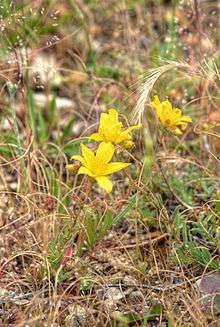 |
[46][19][30][24] |
Drosocarpium
Drosocarpium Spach contains small perennial herbs that are found near the Mediterranean. H. richeri has 3 subspecies.
Species
| Binomial | Authority | Type | Habitat | Distribution | Synonyms | Image | References |
|---|---|---|---|---|---|---|---|
| H. ambiguum | Elliott | [5] | |||||
| H. barbatum | Jacq. | Perennial herb | Grassy slopes, meadows, woodland margins, among rocks | Austria, Italy, Balkans |
|
[48][19][16][12][104] | |
| H. bithynicum | Boiss. | Perennial herb | Damp meadows, scrub, woodlands, rocky slopes | Georgia, Turkey (Northern) |
|
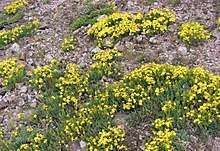 |
[19][16][12][24][17] |
| H. confusum | Rose | [19][16][30][31] | |||||
| H. montbretii | Spach | Perennial herb | Damp places among rocks, on calcareous soil | Balkans, Turkey, Syria, Lebanon, Russia (Southwest) |
|
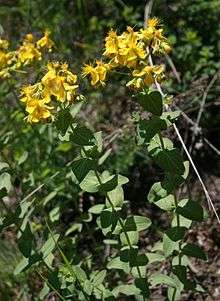 |
[19][13][31][40][94] |
| H. perfoliatum | L. | Perennial herb | Meadows, shale banks, among rocks in shade | Iberia, North Africa, France (South), Italy, Greece, Turkey |
|
[13][31][25][32][88] | |
| H. richeri | Vill. | Perennial herb | Woods, meadows, on limestone/granitic soil | Balkans, Switzerland (Alps), Spain (Pyrenees) |
|
[19][30][31][17][28] | |
| H. rochelii | Griseb. & Schenk | Perennial herb | Grasslands, rocky ground (calcareous) | Balkans |
|
[19][16] | |
| H. rumeliacum | Boiss. | Perennial herb | Stony/rocky places, in woodland clearings | Balkans | None | [80][70][19][17][13] | |
| H. spruneri | Boiss. | Perennial herb | Woods, fallows, rocky slopes, on limestone/schist | Italy, Croatia, Balkans (South) |
|
[19][30] | |
| H. trichocaulon | Boiss. & Heldr. | Perennial herb | Rocky places, ledges, clayey areas | Crete (West) |
|
[19][30][13][69] | |
| H. umbellatum | A. Kern. | Perennial herb | Woods, gorges, on calcareous soil | Balkans |
|
[19][30] | |
| H. vesiculosum | Griseb. | Perennial herb | Woods, on moist ground | Greece, Turkey | None | [19][30][13] |
Nothospecies
| Binomial | Authority | Type | Habitat | Distribution | Parentage | Synonyms | Image | References |
|---|---|---|---|---|---|---|---|---|
| H. × reinosae | A. Ramos | Perennial herb | In cultivation only | Spain | H. perforatum × H. richeri subsp. burseri | None | [5][1][55] |
Elodeoida
Elodeoida N. Robson contains 7 species of annual and perennial herbs. Its type species is H. elodeoides.
Species
| Binomial | Authority | Type | Habitat | Distribution | Synonyms | Image | References |
|---|---|---|---|---|---|---|---|
| H. austroyunnanicum | L.H. Wu & D.P. Yang | Perennial herb | Roadsides, dry waste areas | China | [46][74][4] | ||
| H. elodeoides | Choisy | Perennial herb | Forests, thickets, grassy slopes | China, Myanmar, India, Bhutan, Nepal |
|
[46][62][74][4] | |
| H. hubeiense | L.H. Wu & D.P. Yang | Perennial herb | Thickets | China | [46][74] | ||
| H. kingdonii | N. Robson | Perennial herb | Rice paddies, grassy slopes | China, Myanmar, India | [46][74][4] | ||
| H. petiolulatum | Hook.f. & Thomson ex Dyer | Perennial herb / annual herb | Steep slopes, thickets, roadsides, grasslands | China, India, Southeast Asia |
|
[46][74][86] | |
| H. qinlingense | X.C.Du & Y.Ren | Perennial herb | Exposed slopes, secondary forest | China | None | [46][74][106] | |
| H. seniawinii | Maxim. | Perennial herb | Slopes, grasslands, roadsides | Southeast China |
|
[46][31][74][4] |
Graveolentia
Graveolentia N. Robson is a diverse section whose type species is H. graveolens.
Species
| Binomial | Authority | Type | Habitat | Distribution | Synonyms | Image | References |
|---|---|---|---|---|---|---|---|
| H. collinum | Schltdl. & Cham. | Wiry perennial herb | Dry gravel banks | Mexico |
|
[5][21] | |
| H. epigeium | R.Keller | Wiry perennial herb | Open forest, banks, limestone cliffs | Mexico, Guatemala |
|
[5][1] | |
| H. formosum | Kunth | Perennial herb | Open grassy slopes, forests | Mexico |
|
_in_Logan_Pass_-_Flickr_-_Jay_Sturner.jpg) |
[76][105][40] |
| H. graveolens | Buckley | Perennial herb | Open moist areas, rocky roadside banks | United States |
|
[80][70][47][99][100] | |
| H. macvaughii | N. Robson | Perennial herb | Woodlands, shady ravines | Mexico | [48][31] | ||
| H. oaxacanum | R. Keller | Wiry perennial herb/ Suffrutex | Open grassy slopes, forest margins | Guatemala, Mexico | [42][31] | ||
| H. pringlei | S. Watson | Perennial herb | Open woodland, shrubby slopes | Mexico |
|
[42][1] | |
| H. pseudomaculatum | Bush | Perennial herb | Wooded shady areas, in fields and on roadsides | United States |
|
[80][70][98][99][100] | |
| H. punctatum | Lam. | Perennial herb | Slightly shaded areas, dry or marshy habitats | Canada, United States |
|
.jpg) |
[102][107][103][99][31] |
Nothospecies
| Binomial | Authority | Type | Habitat | Distribution | Parentage | Synonyms | Image | References |
|---|---|---|---|---|---|---|---|---|
| H. × mitchellianum | Rydb. | Unknown (Perennial herb?) | Unknown | United States (North Carolina, Tennessee, Virginia) |
|
[108][109][110][99][100] |
Heterophylla
Heterophylla N. Robson contains a single shrublet, H. heterophyllum, from which the section derives its name.
Species
| Binomial | Authority | Type | Habitat | Distribution | Synonyms | Image | References |
|---|---|---|---|---|---|---|---|
| H. heterophyllum | Vent. | Shrublet | Dry clearings, woodlands | Turkey | None | _(9340619637).jpg) |
[48][42][24][40][104] |
Hirtella
Hirtella Stef. contains perennial herbs averaging 80 cm in height.
Species
| Binomial | Authority | Type | Habitat | Distribution | Synonyms | Image | References |
|---|---|---|---|---|---|---|---|
| Subsection Platyadenum | |||||||
| H. amblysepalum | Hochst. | Perennial herb | Dry woodland, field margins | Israel, Lebanon, Syria, Turkey, Iraq, Iran |
|
[46][16][30][24][26] | |
| H. asperulum | Jaub. & Spach | .jpg) |
[20][21] | ||||
| H. capitatum | Choisy | [16][24][21] | |||||
| H. hedgei | N. Robson | ||||||
| H. helianthemoides | (Spach) Boiss. | [1][24] | |||||
| H. hirtellum | (Spach) Boiss. | [23] | |||||
| H. libanoticum | N. Robson | Perennial herb | Stony ground, damp rocky clefts | Lebanon, Syria |
|
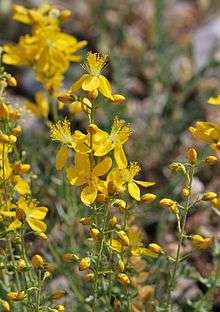 |
[42][26] |
| H. lysimachioides | Boiss. & Noë | [30][24] | |||||
| H. olivieri | (Spach) Boiss. | .jpg) |
[30][24] | ||||
| H. pseudolaeve | N. Robson | [16][24] | |||||
| H. retusum | Aucher ex Jaub. & Spach | Perennial herb | Steppe, hillsides, field margins | Syria, Turkey, Iraq |
|
.jpg) |
[5][16][30][24] |
| H. scabroides | N. Robson & Poulter | [20][30][24] | |||||
| H. scabrum | L. |  |
[111][30][13][31][26] | ||||
| H. spectabile | Jaub. & Spach | [30][24][40] | |||||
| H. thymbrifolium | Boiss. & Noë | Perennial herb | [30][24] | ||||
| H. thymopsis | Boiss. | [30][24] | |||||
| H. vermiculare | Boiss. & Hausskn. | .jpg) |
[23] | ||||
| Subsection Stenadenum | |||||||
| H. apiculatum | (N. Robson) Sennikov | [1] | |||||
| H. apricum | Kar. & Kir. | [42][16][30][24] | |||||
| H. callithyrsum | Coss. | [12][32] | |||||
| H. davisii | N. Robson | [20][16][30][24] | |||||
| H. elongatum | Ledeb. ex Rchb. | [16][30][24][32][74] | |||||
| H. hyssopifolium | Chaix |  |
[19][12][13][17][32] | ||||
| H. karjaginii | Rzazade | [1] | |||||
| H. microcalycinum | Boiss. & Heldr. | ||||||
| H. salsolifolium | Hand.-Mazz. | .jpg) |
[23][30][24] | ||||
| H. sorgerae | N. Robson | [20][16][30][24] | |||||
| H. tymphresteum | Boiss. & Spruner | [1] | |||||
Humifusoideum
Humifusoideum R. Keller, also called Pulogensia, contains 6 species. Its type species is H. peplidifolium. H. beccarii has two subspecies: H. beccarii beccarii and H. beccarii steenisii.
Species
| Binomial | Authority | Type | Habitat | Distribution | Synonyms | Image | References |
|---|---|---|---|---|---|---|---|
| H. beccarii | N. Robson | Perennial/annual herb | Damp places in vegetation | Indonesia (Sumatra, Java) |
|
[42][1][21][40][86] | |
| H. nagasawae | Hayata | Perennial herb/shrublet | Stony/rocky slopes, roadsides, forests | Taiwan |
|
[112][40][74][4] | |
| H. natalense | J.M. Wood & M.S. Evans | Perennial herb | Damp grasslands | South Africa, Swaziland |
|
[42][31][32] | |
| H. nokoense | Ohwi | Perennial herb | Mountain slopes | Taiwan | None | [47][74][4] | |
| H. peplidifolium | A. Rich. | Perennial herb | Marshes, streamsides, roadsides, pastures, moorland grasslands | Sub-saharan Africa |
|
[33][35][38][36][15] | |
| H. wilmsii | R. Keller | Perennial herb | Damp places, mountain slopes | Zimbabwe, South Africa, Madagascar |
|
[42][47][32][35][94] |
Hypericum
Hypericum, sometimes referred to as the "type section" of the genus, contains perennial herbs and very few suffrutices.
Species
| Binomial | Authority | Type | Habitat | Distribution | Synonyms | Image | References |
|---|---|---|---|---|---|---|---|
| Subsection Erecta | |||||||
| H. asahinae | Makino | Perennial herb | Japan | None | [5] | ||
| H. elegans | Stephan ex Willd. | Perennial herb | Well-drained areas, meadows, steppe. on chalk and limestone | Russia, Germany, Czechia, Slovakia, Poland, Hungary, Romania, Serbia, Bulgaria, Turkey |
|
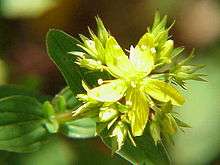 |
[23][16][12][13][24] |
| H. erectum | Thunb. | Perennial herb | Grassy slopes, dry woods. thickets | Russia. Korea, Japan, Taiwan. China |
|
[80][13][78][17][28] | |
| H. furusei | N. Robson | Perennial herb | Japan |
|
[42] | ||
| H. gracillimum | Koidz. | Perennial herb | Japan |
|
[20] | ||
| H. hachijyoense | Nakai | Perennial herb | Mountainous regions | Japan (Honshū) | None | [1] | |
| H. hakonense | Franch. & Sav. | [47][14][17] | |||||
| H. kawaranum | N. Robson | [5] | |||||
| H. kinashianum | Koidz. | [20] | |||||
| H. kitamense | (Y.Kimura) N. Robson | ||||||
| H. kiusianum | Koidz. | [1][17] | |||||
| H. kurodakeanum | N. Robson | ||||||
| H. nikkoense | Makino | ||||||
| H. nuporoense | N. Robson | [1] | |||||
| H. ovalifolium | Koidz. | ||||||
| H. pseudoerectum | N. Robson | [23] | |||||
| H. pseudopetiolatum | R.Keller | [113][114][13][86][4] | |||||
| H. taihezanense | Sasaki ex S.Suzuki | [47][74][4] | |||||
| H. uniglandulosum | Hausskn. ex Bornm. | [20][16][30][24] | |||||
| H. vulcanicum | Koidz. | [5] | |||||
| H. watanabei | N. Robson | ||||||
| H. yamamotoanum | H.Koidz. | [1] | |||||
| H. yamamotoi | Miyabe & Kimura | [42] | |||||
| Subsection Hypericum | |||||||
| Series Hypericum | |||||||
| H. attenuatum | Fisch. ex Choisy | [31][78][14][28][74] | |||||
| H. iwate-littorale | H.Koidz. | [23][1] | |||||
| H. maculatum | Crantz |
|
[70][76][81][27][59] | ||||
| H. momoseanum | Makino | [5] | |||||
| H. perforatum | L. |
|
 |
[61][103][107][79][115] | |||
| H. scouleri | Hook. |
|
[80][61][47][99][43] | ||||
| H. tetrapterum | Fr. |
|
[76][116][115][81][59] | ||||
| H. triquetrifolium | Turra |
|
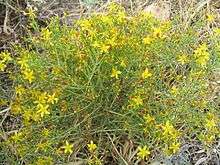 |
[44][25][26][77][69] | |||
| H. undulatum | Schousb. ex Willd. |
|
[116][30][81][59][28] | ||||
| H. yezoense | Maxim. | [46] | |||||
| Series Senanensia | |||||||
| H. enshiense | L.H. Wu & F.S. Wang | [74][4] | |||||
| H. faberi | R.Keller | [74][4] | |||||
| H. kamtschaticum | Ledeb. | [42][13][78][14][17] | |||||
| H. nakaii | H. Koidz. | [5] | |||||
| H. oliganthum | Franch. & Sav. | [20] | |||||
| H. pibairense | (Miyabe & Y.Kimura) N. Robson | [1] | |||||
| H. senanense | Maxim. | [1] | |||||
| H. sikokumontanum | Makino | [47][17] | |||||
Nothospecies
| Binomial | Authority | Type | Habitat | Distribution | Parentage | Synonyms | Image | References |
|---|---|---|---|---|---|---|---|---|
| H. × desetangsii | Lamotte | British Isles, Scandinavia, Western Europe, Balkans | H. perforatum × H. maculatum |
|
[71][52][117][81][40] | |||
| H. × hyugamontanum | Y.Kimura | Perennial herb | Disturbed areas | Japan (Kyushu) | [5][108] | |||
| H. × laschii | A.Fröhl. | Scandinavia, France, Central Europe |
|
[5][52][118][42][55] | ||||
| H. × medium | Peterm. | Austria, Czech Republic, France, Germany, Romania |
|
[5][118][52] |
Inodora
Inodora Stef. contains one species, a shrub called H. xylosteifolium or sometimes H. inodorum.
Description
H. xylosteifolium grows to be approximately 1.5 meters, and is a deciduous plant. It typically has anywhere from 1-7 flowers, which are terminal and sometimes have subsidiary branches. The flowers are 1.5-3 cm in diameter and are stellate and rounded. Its anthers are yellow-orange and its stamen are in fascicles in groups of 10-11.[6]
Species
| Binomial | Authority | Type | Habitat | Distribution | Synonyms | Image | References |
|---|---|---|---|---|---|---|---|
| H. xylosteifolium | (Spach) N. Robson | Shrub | Forests, shady banks, cliffs | Turkey, Russia |
|
[48][42][65][81][104] |
Monanthema
Monanthema N. Robson contains 7 perennial herbs that grow up to 40 cm tall. One of its species, H. monanthemum, has two subspecies: H. monanthemum filicaule and H. monanthemum monanthemum.
Species
| Binomial | Authority | Type | Habitat | Distribution | Synonyms | Image | References |
|---|---|---|---|---|---|---|---|
| H. daliense | N. Robson | China | [46][74][4] | ||||
| H. himalaicum | N. Robson | China, Bhutan, India, Nepal, Pakistan |
|
[46][62][74][4] | |||
| H. ludlowii | N. Robson | China, Bhutan | [46][62][74][4] | ||||
| H. monanthemum | Hook.f. & Thomson ex Dyer | Bhutan, China, India, Myanmar, Nepal | [46][13][74][4] | ||||
| H. subcordatum | (R.Keller) N. Robson | China |
|
[46][74][4][23] | |||
| H. trigonum | Hand.-Mazz. | China, Myanmar | [46][74][4] | ||||
| H. wightianum | Wall. ex Wight & Arn. | Bhutan, China, India, Laos, Myanmar, Sri Lanka, Thailand |
|
[46][62][40][74][4] |
Myriandra
Myriandra (Spach) R. Keller contains shrubs, shrublets, and perennial herbs that grow to be up to 4.5 m.
Species
| Binomial | Authority | Type | Habitat | Distribution | Synonyms | Image | References |
|---|---|---|---|---|---|---|---|
| Subsection Ascyrum | |||||||
| H. crux-andreae | (L.) Crantz |
|
[98][119][120][99][100] | ||||
| H. edisonianum | (Small) W.P. Adams & N. Robson |
|
[80][70][98][99][100] | ||||
| H. hypericoides | (L.) Crantz | Shrub |
|
_(6757577093).jpg) |
[98][119][120][99][100] | ||
| H. suffruticosum | W.P. Adams & N. Robson |
|
[80][76][98][120][99] | ||||
| H. tetrapetalum | Lam. |
|
[80][70][76][98][99] | ||||
| Subsection Brathydium | |||||||
| H. dolabriforme | Vent. |
|
[70][103][76][99][100] | ||||
| H. myrtifolium | Lam. |
|
[70][76][98][99][100] | ||||
| Subsection Centrosperma | |||||||
| H. brachyphyllum | (Spach) Steud. |
|
[80][76][98][99][100] | ||||
| H. chamaenerium | (Spach) Steud. |
|
[46][1] | ||||
| H. chapmanii | W.P. Adams |
|
[80][70][76][100][121] | ||||
| H. densiflorum | Pursh |
|
[103][120][62][99][100] | ||||
| H. exile | W.P. Adams |
|
[80][70][98][100] | ||||
| H. fasciculatum | Lam. |
|
[80][98][120][99][100] | ||||
| H. frondosum | Michx. |
|
[103][98][99][100][65] | ||||
| H. galioides | Lam. |
|
[98][119][120][100][65] | ||||
| H. glomeratum | Small | [20][31] | |||||
| H. kalmianum | L. | Shrublet | United States, Canada |
|
[102][107][99][28][122] | ||
| H. lissophloeus | W.P. Adams |
|
[70][76][98][100][85] | ||||
| H. lloydii | (Svenson) P.B.Adams |
|
[80][70][120][99][100] | ||||
| H. lobocarpum | Gatt. |
|
[80][70][76][100][121] | ||||
| H. longistylum | Oliv. | [40][74][4] | |||||
| H. lydium | Boiss. | .jpg) |
[48][30][24] | ||||
| H. nitidum | Lam. |
|
[76][98][120][100][121] | ||||
| H. opacum | Torr. & A. Gray | [48][31] | |||||
| H. prolificum | L. |
|
[103][98][120][99][85] | ||||
| H. swinkianum | G.Wilh. & L. Rericha | Shrub | Sandy wetlands, prairies, woodland openings | United States (Illinois, Indiana, Michigan) |
|
[123][102][31][124] | |
| H. tenuifolium | Pursh | Shrub | Dry sandy woods, dunes, hollows, lowland areas | United States (Florida, Alabama) |
|
 |
[120][20][31][121][97] |
| Subsection Pseudobrathydium | |||||||
| H. buckleyi | M.A.Curtis | Shrub | Seepage areas, moist crevices, ditches | United States |
|
[120][99][100][31][65] | |
| Subsection Suturosperma | |||||||
| H. adpressum | W.P.C. Barton | Perennial herb | Marshes, pond margins, ditches, bogs | United States |
|
 |
[102] |
| H. apocynifolium | Small | Shrub | Stream banks, moist woods, coastal plain | United States |
|
[76][98][100][31][121] | |
| H. cistifolium | Lam. | Shrub/subshrub | Moist pine flatwoods, bogs and swamps, ditches and roadsides | United States |
|
[98][120][62][99][100] | |
| H. ellipticum | Hook. | Perennial herb | Water margins, wet meadows, swamps | Canada, United States |
|
[102][107][103][99][100] | |
| H. microsepalum | (Torr. & A. Gray) A. Gray ex S. Watson | Shrub | Moist pine flatwoods, damp sandy areas | United States (Florida, Georgia) |
|
[70][76][98][99][100] | |
| H. nudiflorum | Michx. ex Willd. | Shrub | Stream banks, moist woodland, swamps, on sand | United States |
|
[70][98][120][99][100] | |
| H. sphaerocarpum | Michx. | Subshrub/perennial herb | Barren embankments, prairies, rocky outcrops, sandy streambanks | United States |
|
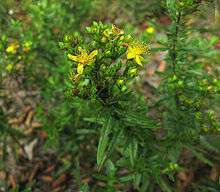 |
[85][76][99][101][122] |
Oligostema
Oligostema (Boiss.) Stef. consists of perennial and annual herbs up to 75 cm tall.
Species
| Binomial | Authority | Type | Habitat | Distribution | Synonyms | Image | References |
|---|---|---|---|---|---|---|---|
| H. andjerinum | Font Quer & Pau | Perennial herb | Mountain slopes, calcareous clay | Morocco | None | [23][20][16][32][21] | |
| H. australe | Ten. | Perennial herb | Woodlands, scrub, grassy slopes | France, Italy, Tunisia, Algeria, Morocco, Spain |
|
[19][125][16][12][44] | |
| H. humifusum | L. | Perennial herb/ biennial herb/ annual herb | Open habitats, acidic soil, moorland, open woodland | Europe, North Africa, introduced to South Africa and Oceania |
|
 |
[126][62][100][81][28] |
| H. kelleri | Bald. | Perennial herb | Flat clay depressions, Field margins | Crete | None | [80][19][17][69] | |
| H. linariifolium | Vahl | Perennial herb | Open stony slopes on acidic soil | British Isles, France, Iberia |
|
[19][1][81][14][17] | |
| H. repens | L. | Perennial herb | Dry stony ground, grazed pastures, open woodlands | Cyprus[Note 1] | None | [23][30][25][14][32] |
Nothospecies
| Binomial | Authority | Type | Habitat | Distribution | Parentage | Synonyms | Image | References |
|---|---|---|---|---|---|---|---|---|
| H. × caesariense | Druce ex N. Robson | Perennial herb | Unknown | Scotland, Northern England | H. linariifolium Vahl × H. humifusum L. | None | [46][55] |
Olympia
Olympia (Spach) Nymam contains four dwarf shrubs. Its type species is H. olympicum.
Species
| Binomial | Authority | Type | Habitat | Distribution | Synonyms | Image | References |
|---|---|---|---|---|---|---|---|
| H. auriculatum | (N. Robson & Hub.-Mor.) N. Robson | Shrub/suffrutex | In forests, among rocks | Southern Turkey |
|
[48][20][94] | |
| H. lycium | (N. Robson & Hub.-Mor.) N. Robson | Shrub/suffrutex | Southwestern Turkey | [48][1][55] | |||
| H. olympicum | L. | Shrub/suffrutex | Sandy/stony ground among rocks, open areas in forests | Balkans |
|
 |
[48][62][77][89][104] |
| H. polyphyllum | Boiss. & Balansa | Shrub/suffrutex | Sandy/stony places on calcareous substrate | Southeastern Turkey, Syria |
|
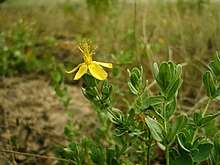 |
[80][48][24][14][17] |
Origanifolia
Origanifolia Spach contains 13 species of shrub-like perennial herbs. Its type species is H. origanifolium.
Species
| Binomial | Authority | Type | Habitat | Distribution | Synonyms | Image | References |
|---|---|---|---|---|---|---|---|
| H. albiflorum | (Hub.-Mor.) N. Robson | Perennial herb | Rocky or sandy ground | Turkey |
|
[46] | |
| H. aviculariifolium | Jaub. & Spach | Perennial herb | Unknown | Turkey | None | [19][16][12][24][89] | |
| H. bourgaei | (Boiss.) N. Robson | Perennial herb | Fallow ground on clay | Turkey |
|
[46] | |
| H. cymbiferum | Boiss. & Balansa | Perennial herb | Calcareous hilly areas | Turkey |
|
[46] | |
| H. ichelense | N. Robson | Perennial herb | Forest plantations | Turkey | None | [46] | |
| H. imbricatum | Poulter | Perennial herb | Low rocks | Turkey | None | [46][30][24] | |
| H. laxiflorum | N. Robson | Perennial herb | Open woodlands, mountain grasslands | Turkey |
|
[46] | |
| H. leprosum | Boiss. | Perennial herb | Rocky or stony ground | Turkey | None | [46] | |
| H. origanifolium | Willd. | Perennial herb | Dry grassy slopes, calcareous cliff ledges | Georgia, Syria, Turkey |
|
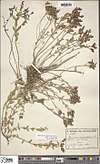 |
[46][20][24][14][104] |
| H. papillare | Boiss. & Heldr. | Perennial herb | Hills, roadsides | Turkey |
|
[46] | |
| H. salsugineum | N. Robson & Hub.-Mor. | Perennial herb | Salt scrub | Turkey | None | [46][16][30][24] | |
| H. trachyphyllum | Griseb. | Perennial herb | Open slopes, in stony areas or among clay | Turkey |
|
[46][20] | |
| H. uniflorum | Boiss. & Heldr. | Perennial herb | Steep screes, among rocks | Turkey |
|
[46] |
Psorophytum
Psorophytum (Spach) Nyman contains a single species, H. balearicum.
Species
| Binomial | Authority | Type | Habitat | Distribution | Synonyms | Image | References |
|---|---|---|---|---|---|---|---|
| H. balearicum | L. | Shrub/small tree | Dry woods, among rocks | Spain (Balearic Islands) |
|
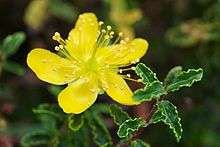 |
[37][127][47][16][104] |
Roscyna
Roscyna (Spach) R. Keller contains 2 species: its type species, H. ascyron, and H. przewalskii. Roscyna was once considered to be its own individual genus which contained only the two species. H. ascyron has two subspecies, H. ascyron ascyron and H. ascyron gebleri.
Species
| Binomial | Authority | Type | Habitat | Distribution | Synonyms | Image | References |
|---|---|---|---|---|---|---|---|
| H. ascyron | L. | Perennial herb | Meadows, rocky slopes, river banks | Russia, Southeast Asia, Canada, U.S.A. |
|
[102][103][107][99][122] | |
| H. przewalskii | Maxim. | Perennial herb | Mountain slopes, thickets, roadsides | China |
|
[47][48][31][40][74] |
Sampsonia
Sampsonia N. Robson two species: its type species, H. sampsonii, and H. assamicum.
Species
| Binomial | Authority | Type | Habitat | Distribution | Synonyms | Image | References |
|---|---|---|---|---|---|---|---|
| H. assamicum | S.N.Biswas | Perennial herb/suffruticose herb | Lowland jungles | India |
|
[48][128][62] | |
| H. sampsonii | Hance | Perennial herb/suffruticose herb | Thickets, streamsides, roadsides | China, Japan, Southeast Asia |
|
[47][31][78][129][43] |
Santomasia
Santomasia (N. Robson) N. Robson contains a single species, H. steyermarkii.
Species
| Binomial | Authority | Type | Habitat | Distribution | Synonyms | Image | References |
|---|---|---|---|---|---|---|---|
| H. steyermarkii | Standl. | Unknown | Grassy slopes, near volcanoes | Guatemala, Mexico |
|
[5][20] |
Taeniocarpium
Taeniocarpium Jaub. & Spach contains small wiry perennial herbs up to 1.1 meters tall.
Species
| Binomial | Authority | Type | Habitat | Distribution | Synonyms | Image | References |
|---|---|---|---|---|---|---|---|
| H. armenum | Jaub. & Spach | [23][20][16][13][21] | |||||
| H. confertum | Choisy | [25][14][17][21] | |||||
| H. crenulatum | Boiss. | [46][16][30][21] | |||||
| H. fissurale | Woronow |
|
[37][16][24][22] | ||||
| H. havvae | Güner | [5][24] | |||||
| H. hirsutum | L. |
|
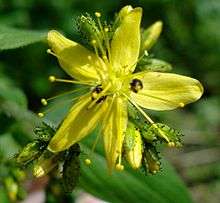 |
[12][115][130][81][27] | |||
| H. kotschyanum | Boiss. | [20][16][30][13][17] | |||||
| H. linarioides | Bosse | [19][24][14][17][104] | |||||
| H. malatyanum | Peșmen | [16][30][24] | |||||
| H. marginatum | Woronow | [20][16] | |||||
| H. neurocalycinum | Boiss. & Heldr. | [16][24] | |||||
| H. nummularioides | Trautv. | [16][30][24] | |||||
| H. nummularium | L. | [19][30][17][88][40] | |||||
| H. peshmenii | Yıld. | [5][24] | |||||
| H. pruinatum | Boiss. & Balansa | [20][16][30][24][14] | |||||
| H. pseudorepens | N. Robson | [1] | |||||
| H. pulchrum | L. |
|
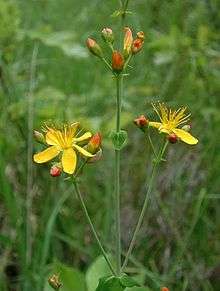 |
[80][70][76][13][81] | |||
| H. pumilio | Bornm. | [5][20][16] | |||||
| H. saxifragum | N. Robson & Hub.-Mor. | [23][16][30][24] | |||||
| H. taygeteum | Quézel & Contandr. | [19][16][30][17] | |||||
| H. theodori | Woronow |
|
[37][47] | ||||
| H. thymifolium | Banks & Sol. | [47][30][24][26] | |||||
| H. vaccinioides | N. Robson | [42][30] | |||||
| H. venustum | Fenzl | [23][16][24] |
Takasagoya
Takasagoya (Y.Kimura) N. Robson contains deciduous shrubs and shrublets that grow up to 1.5 m tall.
Species
| Binomial | Authority | Type | Habitat | Distribution | Synonyms | Image | References |
|---|---|---|---|---|---|---|---|
| H. formosanum | Maxim. | Shrub | On banks, in stony areas | Taiwan |
|
[70][47][48][74][4] | |
| H. geminiflorum | Hemsl. | Shrub | Stony areas | Taiwan, Philippines | None | [40][74][86][4] | |
| H. nakamurai | (Masam.) N. Robson | Shrub | Limestone rock crevices | Taiwan |
|
[74][4] | |
| H. senkakuinsulare | Hatus. | Shrub | Rocky mountaintops | Ryukyu Islands | None | [48][20] | |
| H. subalatum | Hayata | Shrub | Limestone rock crevices | Taiwan |
|
[47][74][112][4] |
Triadenoides
Triadenoides Jaub. & Spach contains 7 species. H. haplophylloides has two subspecies, H. haplophylloides haplophylloides and H. haplophylloides devollense.
Species
| Binomial | Authority | Type | Habitat | Distribution | Synonyms | Image | References |
|---|---|---|---|---|---|---|---|
| H. fieriense | N. Robson | Shrub | Among low scrub | Socotra | None | [37][1] | |
| H. haplophylloides | Halácsy & Bald. | None | [48][19][131][12][17] | ||||
| H. musadoganii | Yıld. | None | [48][20] | ||||
| H. pallens | Banks & Solander | Shrublet | Among limestone rock | Turkey, Syria, Lebanon |
|
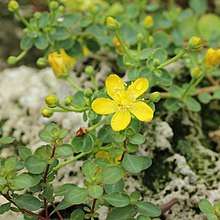 |
[48][13][24][17] |
| H. scopulorum | Balf.f. | Shrub | Thickets, rocky/grassy slopes | Socotra | None | 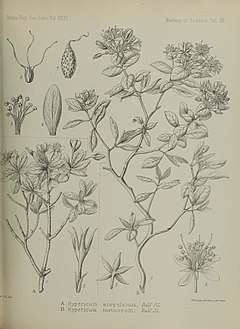 |
[37][47][40][94] |
| H. ternatum | Poulter | Shrublet | Limestone fissures, cliffs | Turkey | None | [42][30][24] | |
| H. tortuosum | Balf.f. | Shrub/Shrublet | Among rocks and crags | Socotra | None | [37][47][40] |
Trigynobrathys
Trigynobrathys (Y. Kimura) N. Robson contains shrubs and subshrubs as well as annual and perennial herbs that are very diverse in size and shape.
Species
| Binomial | Authority | Type | Habitat | Distribution | Synonyms | Image | References |
|---|---|---|---|---|---|---|---|
| Subsection Connatum | |||||||
| H. brasiliense | Choisy | Subshrub (Annual herb?) |
|
[23][31][14][40][92] | |||
| H. caespitosum | Cham. & Schltdl. | [5][21] | |||||
| H. campestre | Cham. & Schltdl. | [42][21][92] | |||||
| H. caprifoliatum | Cham. & Schltdl. | [20][31][14][21] | |||||
| H. carinatum | Griseb. | [1][14][21] | |||||
| H. cavernicola | L.B. Sm. | [1][21] | |||||
| H. connatum | Lam. | [20][91][21][92][132] | |||||
| H. cordatum | (Vell.) N. Robson | [23][1][21][40] | |||||
| H. cumulicola | (Small) P.B. Adams |
|
[80][98][100][133][134] | ||||
| H. denticulatum | Walter |
|
[70][98][13][99][100] | ||||
| H. denudatum | A. St.-Hil. | ||||||
| H. erythreae | (Spach) Steud. |
|
[70][100][31][121] | ||||
| H. gramineum | G.Forst. |
|
.jpg) |
[76][62][100][60][43] | |||
| H. harperi | R.Keller |
|
[80][70][76][98][100] | ||||
| H. legrandii | L.B. Sm. | [20][40] | |||||
| H. linoides | A. St.-Hil. | [1] | |||||
| H. lorentzianum | Gilg ex R. Keller | ||||||
| H. majus | (A.Gray) Britton |
|
[102][107][103][99][100] | ||||
| H. microlicioides | L.B. Sm. | [5] | |||||
| H. myrianthum | Cham. & Schltdl. | [20][14][40] | |||||
| H. polyanthemum | Klotzsch ex Reichardt | [23] | |||||
| H. rigidum | A. St.-Hil. | [22] | |||||
| H. salvadorense | N. Robson | [1][22] | |||||
| H. setosum | L. |
|
[80][70][98][47][99] | ||||
| H. silenoides | Juss. |
|
[31][91][87][40][92] | ||||
| H. teretiusculum | A. St.-Hil. | [20][132] | |||||
| H. ternum | A. St.-Hil. | [42][31] | |||||
| H. virgatum | Lam. |
|
[70][47][100][31][121] | ||||
| Subsection Knifa | |||||||
| H. anagalloides | Cham. & Schltdl. | Annual herb/Perennial herb | Bogs, ditches, water margins, wet areas | Canada, United States, Mexico |
|
[37][76][61][99][100] | |
| H. aphyllum | Lundell | Annual herb | Open woodlands, lowlands | Belize |
|
_(7361692630).jpg) |
[23][21][22] |
| H. arenarioides | A. Rich. | Annual herb | Damp places, lowlands | Cuba |
|
[5][1][21] | |
| H. boreale | (Britton) H. P. Bicknell | Eastern Canada, New England |
|
.jpg) |
[102][103][107][99][135] | ||
| H. brevistylum | Choisy | [5][91][87][92] | |||||
| H. canadense | L. |
|
[102][103][99][100][87] | ||||
| H. globuliferum | R. Keller | [1][22] | |||||
| H. gymnanthum | Engelm. & A.Gray | [98][19][99][100][122] | |||||
| H. humbertii | Staner | [46][32] | |||||
| H. japonicum | Thunb. |
|
 |
[136][60][78][129][132] | |||
| H. killipii | N. Robson | [20][22] | |||||
| H. lalandii | Choisy | [32][33][137][36][15] | |||||
| H. monadenum | N. Robson | [30][31][24] | |||||
| H. moranense | Kunth | [31][91] | |||||
| H. mutilum | L. |
|
[102][61][103][122][105] | ||||
| H. oligandrum | Milne-Redh. | [23][32][33][138][39] | |||||
| H. parvulum | Greene | [80][70][76][100][31] | |||||
| H. pauciflorum | Kunth | [80][70][76][100][31] | |||||
| H. paucifolium | S. Watson | [76][31][91] | |||||
| H. pedersenii | N. Robson | [5][1] | |||||
| H. philonotis | Schltdl. & Cham. | [46][31][91][40] | |||||
| H. pleiostylum | C. Rodr. Jim. | [20][55] | |||||
| H. pratense | Schltdl. & Cham. |
|
[47][31][87][14] | ||||
| H. pumilum | Sessé & Moc. | Mexico | [23][55] | ||||
| H. relictum | N. Robson | [1][55][23][22] | |||||
| H. scioanum | Chiov. | [20][32][38] | |||||
| H. thesiifolium | Kunth | [47][31][87][14][92] | |||||
Nothospecies
| Binomial | Authority | Type | Habitat | Distribution | Parentage | Synonyms | Image | References |
|---|---|---|---|---|---|---|---|---|
| H. × dissimulatum | E.P. Bicknell |
|
[80][70][99][100][76] |
Tripentas
Tripentas (Casp.) N. Robson contains one long-stemmed perennial herb, H. elodes. Tripentas is sometimes separated into its own genus under the synonyms Elodes (Spach) W. Koch, Martia Sprengel, Perforaria Choisy, Spachelodes Y. Kimura, or Tripentas Casp..
Species
| Binomial | Authority | Type | Habitat | Distribution | Synonyms | Image | References |
|---|---|---|---|---|---|---|---|
| H. elodes | L. | Perennial herb | Mires, in shallow water, on acidic peat soil | Austria, Belgium, France, Germany, Italy, Netherlands, Iberia, Slovenia, British Isles |
|
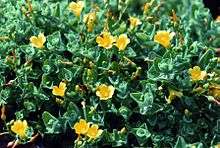 |
[37][19][60][81][59] |
Umbraculoides
Umbraculoides N. Robson contains a single species, H. umbraculoides, for which the section is named.
Species
| Binomial | Authority | Type | Habitat | Distribution | Synonyms | Image | References |
|---|---|---|---|---|---|---|---|
| H. umbraculoides | N. Robson | Deciduous shrub | Unknown | Mexico | None | [46][48][5][23] |
Webbia
Webbia (Spach) R. Keller contains a large deciduous shrub that can grow up to 4 meters tall.
Species
| Binomial | Authority | Type | Habitat | Distribution | Synonyms | Image | References |
|---|---|---|---|---|---|---|---|
| H. canariense | L. | Shrub/Tree | Rocky slopes, cliffs, ravines | Spain (Canary Islands), Portugal (Madeira) |
|
[80][16][61][100][105] |
Incertae sedis
| Binomial | Authority | Type | Habitat | Distribution | Synonyms | Image | References |
|---|---|---|---|---|---|---|---|
| H. callinum | Rose | Unknown | Unknown | Mexico | None | [47][42][68][23] | |
| H. dodonaei | Steud. | Unknown | Unknown | Unknown | None | [1][42] |
Extinct
Hypericum fossils have been found from the Late Eocene to the present day, with the most commonly found part of the plant being the seeds due to their hardiness. However, a small number of leaves and even pollen have also been found as fossils. The oldest fossil recovered was a seed belonging to the species H. antiquum which was found in Northern Asia. This species is considered to be the common ancestor of the Hypericaceae family. [139]
| Binomial | Authority | Fossil Status | Temporal Range | Location | Distribution | Synonyms | Image | References |
|---|---|---|---|---|---|---|---|---|
| H. antiquum | Balueva & Nikitin | Neogene | Russia (Siberia) | None | [139][140] | |||
| H. canatalense | E. Reid | Seeds | Pliocene | France | None | [140] | ||
| H. coriaceum | Nikitin | Seeds | Miocene | Russia | Europe | None | [140] | |
| H. danicum | Friis | Miocene | Denmark | None | [141][142][140] | |||
| H. foveolatum | Dorof. | Seeds | Pliocene | Belarus | Europe | None | [140] | |
| H. miocenicum | Dorof. | Oligocene-Pliocene | None | [139] | ||||
| H. holyi | Friis | Middle Miocene | Denmark | None | [142][139] | |||
| H. rostriformum | Jakub | Seeds | Miocene | Belarus | Europe | None | [140] | |
| H. septestum | Nikitin ex Arbuzova | Miocene | Czech Republic, Russia | None | [143][144][140] | |||
| H. tertiarium | Nikitin | Oligocene-Pliocene | None | [139] |
See also
Notes
- ↑ Extinct in Israel
References
- 1 2 3 4 5 6 7 8 9 10 11 12 13 14 15 16 17 18 19 20 21 22 23 24 25 26 27 28 29 30 31 32 33 34 35 36 37 38 39 40 41 42 43 44 45 46 47 48 49 50 51 "Hypericum". The Plant List. Royal Botanic Gardens, Kew, Missouri Botanical Garden. 2013. Retrieved 19 February 2016.
- 1 2 Robson, N.K.B. (2002-10-31). "Studies in the genus Hypericum L. (Guttiferae) 4(2). Section 9. Hypericum sensu lato (part 2): subsection 1. Hypericum series 1. Hypericum". Bulletin of The Natural History Museum. Botany Series. 32 (02). doi:10.1017/s096804460200004x. ISSN 0968-0446.
- ↑ Nürk, Nicolai M.; Madriñán, Santiago; Carine, Mark A.; Chase, Mark W.; Blattner, Frank R. (2013-01-01). "Molecular phylogenetics and morphological evolution of St. John's wort (Hypericum; Hypericaceae)". Molecular Phylogenetics and Evolution. 66 (1): 1–16. doi:10.1016/j.ympev.2012.08.022. ISSN 1055-7903.
- 1 2 3 4 5 6 7 8 9 10 11 12 13 14 15 16 17 18 19 20 21 22 23 24 25 26 27 28 29 30 31 32 33 34 35 36 37 38 39 40 Xiwen, Li; Robson, Norman (1994). Flora of China (PDF). Science Press & Missouri Botanical Garden. pp. 13: 2–35.
- 1 2 3 4 5 6 7 8 9 10 11 12 13 14 15 16 17 18 19 20 21 22 23 24 25 26 27 28 29 30 31 32 33 34 35 36 37 38 39 40 41 42 43 44 45 46 "Hypericum Tourn. ex L. | Plants of the World Online | Kew Science". plantsoftheworldonline.org. Retrieved 2018-02-05.
- 1 2 3 4 5 6 7 8 9 10 11 12 13 "Nomenclature | Hypericum online". hypericum.myspecies.info. Retrieved 2018-01-25.
- ↑ "St. John's Wort, Hypericum | AquaPlant". aquaplant.tamu.edu. Retrieved 2018-07-31.
- ↑ A-Z encyclopedia of garden plants. Brickell, Christopher., Royal Horticultural Society (Great Britain) ([3rd ed.] ed.). London: Dorling Kindersley in association with the Royal Horticultural Society. 2008. ISBN 9781405332965. OCLC 299238159.
- ↑ Szegedi, A.; Kohnen, R.; Dienel, A.; Kieser, M. (2005-03-05). "Acute treatment of moderate to severe depression with hypericum extract WS 5570 (St John's wort): randomised controlled double blind non-inferiority trial versus paroxetine". BMJ (Clinical Research Ed.). 330 (7490): 503. doi:10.1136/bmj.38356.655266.82. ISSN 1756-1833. PMC 552808. PMID 15708844.
- ↑ Klemow, Kenneth M.; Bartlow, Andrew; Crawford, Justin; Kocher, Neil; Shah, Jay; Ritsick, Michael (2011). Benzie, Iris F. F.; Wachtel-Galor, Sissi, eds. "Medical Attributes of St. John's Wort (Hypericum perforatum)". Herbal Medicine: Biomolecular and Clinical Aspects (2nd ed.). CRC Press/Taylor & Francis. ISBN 9781439807132. PMID 22593920. Retrieved 2018-09-24.
- ↑ Ernst, Edzard (2003). Hypericum: The genus Hypericum. CRC Press. p. 9. ISBN 978-1420023305.
- 1 2 3 4 5 6 7 8 9 10 11 12 13 14 15 16 17 18 19 20 21 "Flora Europaea : Hypericum". rbg-web2.rbge.org.uk. Retrieved 2018-08-03.
- 1 2 3 4 5 6 7 8 9 10 11 12 13 14 15 16 17 18 19 20 21 22 23 24 25 26 27 28 29 30 31 32 33 34 35 36 37 38 39 40 "Hypericum: Royal Horticultural Society". www.rhs.org.uk.
- 1 2 3 4 5 6 7 8 9 10 11 12 13 14 15 16 17 18 19 20 21 22 23 24 25 26 "Genus: Hypericum L". GRIN. Germplasm Resources Information Network. Retrieved 2018-06-08.
- 1 2 3 4 5 6 7 8 9 "PROTA4U Database". Plant Resources of Tropical Africa - PROTA Database. Retrieved 2018-08-23.
- 1 2 3 4 5 6 7 8 9 10 11 12 13 14 15 16 17 18 19 20 21 22 23 24 25 26 27 28 29 30 31 32 33 34 35 36 37 38 39 40 41 42 43 44 45 46 47 "The Euro+Med Plantbase Project". ww2.bgbm.org. Retrieved 2018-08-03.
- 1 2 3 4 5 6 7 8 9 10 11 12 13 14 15 16 17 18 19 20 21 22 23 24 "Hypericum". Alpine Garden Society Plant Encyclopedia. 2011. Retrieved 2018-06-08.
- ↑ "Plant of the Month: Hypericum athoum". Ontario Rock Garden and Hardy Plant Society. Retrieved 2018-06-08.
- 1 2 3 4 5 6 7 8 9 10 11 12 13 14 15 16 17 18 19 20 21 22 23 24 25 26 27 28 29 30 31 32 33 34 35 "Hypericum Taxonomic Classification". European Environment Agency (EUNIS).
- 1 2 3 4 5 6 7 8 9 10 11 12 13 14 15 16 17 18 19 20 21 22 23 24 25 26 27 28 29 30 31 32 33 34 35 36 37 38 39 40 41 42 43 44 45 46 47 48 49 "!Hypericum L". Tropicos. Missouri Botanical Garden. Retrieved 24 May 2018.
- 1 2 3 4 5 6 7 8 9 10 11 12 13 14 15 16 17 18 19 20 21 22 23 24 25 26 27 28 29 30 31 32 33 34 35 36 37 38 39 40 41 42 43 44 45 46 47 "Hypericum [family HYPERICACEAE]". JSTOR Global Plants. Retrieved 2018-08-10.
- 1 2 3 4 5 6 7 8 9 10 11 12 13 14 15 16 17 18 19 20 21 22 23 24 25 26 27 28 29 30 31 32 33 34 35 36 37 38 39 40 41 42 43 44 45 46 47 48 49 50 51 "Global Species : Hypericum". globalspecies.org. Retrieved 2018-09-24.
- 1 2 3 4 5 6 7 8 9 10 11 12 13 14 15 16 17 18 19 20 21 22 23 24 25 26 27 28 29 30 31 32 33 34 35 36 "Hypericum". eElurikkus. 2018-05-20. Retrieved 2018-07-31.
- 1 2 3 4 5 6 7 8 9 10 11 12 13 14 15 16 17 18 19 20 21 22 23 24 25 26 27 28 29 30 31 32 33 34 35 36 37 38 39 40 41 42 43 44 45 46 47 48 49 50 "Hızlı Arama Sonuçları". Türkiye Bitkileri Veri Servisi (Tubives) (in Turkish). Retrieved 2018-07-08.
- 1 2 3 4 5 6 7 "Hypericum". Flora of Cyprus. Retrieved 2018-06-08.
- 1 2 3 4 5 6 7 8 9 Danin, Avinoam. "Analytical Flora: Hypericum". Flora of Israel Online. Retrieved 2018-06-08.
- 1 2 3 "Flowers - St. John's-wort Family". NatureGate. Retrieved 2018-06-08.
- 1 2 3 4 5 6 7 8 9 10 "Hypericum". Henriette's Herbal Homepage. Retrieved 2018-08-11.
- 1 2 3 Aguilar, Marcelino J. del Arco (2018). Vegetation of the Canary Islands. Springer. ISBN 9783319772554.
- 1 2 3 4 5 6 7 8 9 10 11 12 13 14 15 16 17 18 19 20 21 22 23 24 25 26 27 28 29 30 31 32 33 34 35 36 37 38 39 40 41 42 43 44 45 46 47 48 49 50 "PESI Portal - Hypericum L". EU-Nomen. Retrieved 2018-08-06.
- 1 2 3 4 5 6 7 8 9 10 11 12 13 14 15 16 17 18 19 20 21 22 23 24 25 26 27 28 29 30 31 32 33 34 35 36 37 38 39 40 41 42 43 44 45 46 "Hypericaceae Species List". SEINet Arizona-New Mexico Chapter. Retrieved 2018-06-08.
- 1 2 3 4 5 6 7 8 9 10 11 12 13 14 15 16 17 18 19 20 21 22 23 24 25 26 27 28 29 30 "Hypericum L". CJB African Plant Database. Conservatorie et Jardin Botaniques Ville de Geneve. Retrieved 2018-06-08.
- 1 2 3 4 5 6 7 "Hypericum Accepted Species". Arquivo Cientifico Tropical Digital Repository (ACTD). IICT. Retrieved 2018-08-09.
- ↑ Jacobus), Botha, C.J. (Christoffel; Elna, Venter, (2002). "Hypericum species".
- 1 2 3 4 "5168.000 Hypericum L". Flora of Zimbabwe. Retrieved 2018-08-11.
- 1 2 3 "5168.000 Hypericum L". Flora of Mozambique. Retrieved 2018-08-11.
- 1 2 3 4 5 6 7 8 9 10 11 12 13 14 15 16 17 18 19 20 21 22 23 "The IUCN Red List of Threatened Species". www.iucnredlist.org. Retrieved 2018-07-31.
- 1 2 3 4 "5168.000 Hypericum L". Flora of Malawi. Retrieved 2018-08-11.
- 1 2 3 "5168.000 Hypericum L". Flora of Zambia. Retrieved 2018-08-11.
- 1 2 3 4 5 6 7 8 9 10 11 12 13 14 15 16 17 18 19 20 21 22 23 24 25 26 27 28 29 30 31 32 33 34 35 36 37 "Hypericum L. [Guttiferae-Hypericoideae]". Botanical Illustrations. Retrieved 2018-08-11.
- 1 2 "Hypericum". www.floradecanarias.com. Retrieved 2018-10-03.
- 1 2 3 4 5 6 7 8 9 10 11 12 13 14 15 16 17 18 19 20 21 22 23 24 25 26 27 28 29 30 31 32 33 34 35 36 37 38 39 40 41 42 43 44 45 46 "Hypericum L". GBIF. Global Biodiversity Information Facility. 2018-03-25. Retrieved 2018-04-22.
- 1 2 3 4 5 Quattrocchi, Umberto (2016). CRC World Dictionary of Medicinal and Poisonous Plants: Common Names, Scientific Names, Eponyms, Synonyms, and Etymology. CRC Press. ISBN 978-1482250640.
- 1 2 3 4 Mifsud, Stephen. "Hypericaceae Family Profile". Wild Plants of Malta. Retrieved 2018-08-06.
- ↑ "Hypericum scruglii, flora di Sardegna". www.sardegnaflora.it (in Italian). Retrieved 2018-10-03.
- 1 2 3 4 5 6 7 8 9 10 11 12 13 14 15 16 17 18 19 20 21 22 23 24 25 26 27 28 29 30 31 32 33 34 35 36 37 38 39 40 41 42 43 44 45 46 47 Zicha, Ondrej. "BioLib: Biological library". www.biolib.cz (in Czech). Retrieved 2018-01-25.
- 1 2 3 4 5 6 7 8 9 10 11 12 13 14 15 16 17 18 19 20 21 22 23 24 25 26 27 28 29 30 31 32 33 34 35 36 "Genus Hypericum". NaturaLista (in Spanish). Retrieved 2017-12-29.
- 1 2 3 4 5 6 7 8 9 10 11 12 13 14 15 16 17 18 19 20 21 22 23 24 25 26 27 28 "Catalogue of Life - 2014 Annual Checklist :: Taxonomic tree". www.catalogueoflife.org. Retrieved 2018-07-31.
- ↑ Nicolai, Nurk; Blattner, Frank (1967). "Cladistic analysis of morphological characters in Hypericum (Hypericaceae)". Not. Roy. Cure. Gard. Edinb. 27 (5): 197. JSTOR 20774044.
- ↑ Koray; Kurtulus; Okan; Gökhan; Dervis; Onur (2013). "Anatomical studies and conservation status of rare endemic Hypericum sechmenii Ocak&Koyuncu (Sect: Adenosepalum) from EskişehirTurkey". Research Gate (Scientific Journal).
- ↑ Ocak, Atila; Savaroglu, Filiz; Erkara, İsmuhan Potoğlu; Koyuncu, Onur. "Hypericum sechmenii (Hypericaceae), a new species from central Anatolia, Turkey" (PDF). www.annbot.net. Retrieved 2018-10-03.
- 1 2 3 4 Bulleton of the Natural History Museum. 2002. pp. Botany Series.
- 1 2 Nurk, Nicolai (2011). Phylogenetic analyses in St. John's wort (Hypericum): Inferring character evolution and historical biogeography (PDF) (Dissertation). Berlin. pp. 32, 110. Retrieved 2018-04-22.
- ↑ Robson, Norman (1996). "Studies in the genus Hypericum L. (Guttiferae) 6. Sections 20. Myriandra to 28. Elodes". Bull. Nat. Hist. Mus. (London), Bot. 26: 75–271 – via Hypericum MySpecies.
- 1 2 3 4 5 6 7 8 9 10 Barker, Christine. "The International Plant Names Index - home page". ipni.org. Retrieved 2018-09-16.
- 1 2 3 4 5 6 7 "Hypericum". deeproot.co.uk. Retrieved 2018-07-06.
- ↑ Ker, John Bellenden (1817). "Egyptian St. John's-wort". Botanical Register. 3. doi:10.5555/al.ap.visual.cgebtrg0123 (inactive 2018-09-10) – via JSTOR.
- ↑ "Hypericum aegypticum, Dwarf St. John's Wort, Shrub". SanMarcos Growers. Retrieved 2018-08-06.
- 1 2 3 4 5 6 7 "A to Z Thumbnail Index". UK Wildflowers. Retrieved 2018-08-11.
- 1 2 3 4 5 6 7 8 "PlantNET Home Page - National Herbarium of New South Wales". plantnet.rbgsyd.nsw.gov.au. Retrieved 2018-08-07.
- 1 2 3 4 5 6 7 8 9 "Calflora: Plant Search". www.calflora.org. Retrieved 2018-01-11.
- 1 2 3 4 5 6 7 8 9 10 11 12 13 14 15 16 17 18 19 20 21 22 23 24 25 26 27 "Hypericaceae - Hypericum". eFloras of India. 2007–2018.
- 1 2 3 "Plant List by Genus | Landscape Plants | Oregon State University". landscapeplants.oregonstate.edu. Retrieved 2018-08-07.
- ↑ Bramwell, David (1976), "The Endemic Flora of the Canary Islands; Distribution, Relationships and Phytogeography", Biogeography and Ecology in the Canary Islands, Monographiae Biologicae, 30, Springer Netherlands, pp. 207–240, doi:10.1007/978-94-010-1566-0_6, ISBN 9789401015684
- 1 2 3 4 5 6 7 8 9 10 11 12 13 14 15 16 17 18 19 20 21 22 23 24 25 26 "Bean's Trees and Shrubs". www.beanstreesandshrubs.org. Retrieved 2018-08-07.
- ↑ Bramwell, D; Bramwell, Z (1974). Wild Flowers of the Canary Islands. Stanley Thornes (Publishers) Ltd.
- ↑ Scönfelder, P; Scönfelder, I (2005). Die Kosmos Kanarenflora. Kosmos.
- 1 2 3 La biodiversidad en Guanajuato: estudio de Estado. México :: Comisión Nacional para el Conocimiento y Uso de la Biodiversidad (CONABIO),. 2011. doi:10.5962/bhl.title.118977.
- 1 2 3 4 5 6 7 Lenton, Steve. "Cretan Flora". www.cretanflora.com. Retrieved 2018-08-25.
- 1 2 3 4 5 6 7 8 9 10 11 12 13 14 15 16 17 18 19 20 21 22 23 24 25 26 27 28 29 30 31 "Plants Profile for Hypericum". USDA Plants.
- 1 2 Stace, C.A; Preston, C.D.; Pearman, D.A. (2015). Hybrid flora of the British isles. Botanical Society of Britain and Ireland.
- ↑ Crockett, Sara; Robson, Norman (2011-01-01). "Taxonomy and Chemotaxonomy of the Genus Hypericum". Medicinal and Aromatic Plant Science and Biotechnology. 5 (Special Issue 1): 1–13. PMC 3364714. PMID 22662019.
- 1 2 Engler, Adolf (1898). Die Natürlichen Pflanzenfamilien, nebst ihren Guttungen und wichtigeren Arten, Volume 1. W. Engelmann.
- 1 2 3 4 5 6 7 8 9 10 11 12 13 14 15 16 17 18 19 20 21 22 23 24 25 26 27 28 29 30 31 32 33 34 35 36 37 38 39 40 41 42 43 44 45 46 47 "Hypericum". eFloras of China. Retrieved 2018-08-11.
- ↑ "Online Plant Guide Search". onlineplantguide.com. Retrieved 2018-08-10.
- 1 2 3 4 5 6 7 8 9 10 11 12 13 14 15 16 17 18 19 20 21 22 23 24 25 26 27 28 29 30 31 "ITIS Standard Report Page: Hypericum". www.itis.gov. Retrieved 2018-01-13.
- 1 2 3 4 "Hypericum Plants". findmeplants. Retrieved 2018-08-10.
- 1 2 3 4 5 6 7 8 9 "Plants for a Future". pfaf.org. Retrieved 2018-06-08.
- 1 2 "Hypericum Species: Common St. John's wort & Aaron's Beard" (PDF). Garry Oak.
- 1 2 3 4 5 6 7 8 9 10 11 12 13 14 15 16 17 18 19 20 21 22 23 24 25 26 27 28 "Family: Clusiaceae, Genus: Hypericum". davesgarden.com. Retrieved 2018-01-04.
- 1 2 3 4 5 6 7 8 9 10 11 12 "Plant Finder". Online Atlas of the British and Irish Flora. Retrieved 2018-06-08.
- ↑ Murthy, K; Rama, S; Rani, S; Pullaiah, T (2004). "Hypericum gaitii Haines (Hypericaceae), a new record for southern peninsular India". J. Bombay Nat. Hist. Soc. 101: 189–191.
- ↑ Biswas, SN (1972). "Hypericum griffithii Hook. F. et Thoms, ex Dyer emend. S. N. Biswas - a noteworthy flowering plant from eastern Himalayas". Bull. Bot. Surv. India. 13: 160–161.
- ↑ Sahni, KC; Naithani, HB. "Hypericum griffithii Hook. f. et Thoms. ex Dyer: a very rare shrub from Arunachal Pradesh". Indian Forester. 106: 865–868.
- 1 2 3 4 "Plant Finder". www.missouribotanicalgarden.org. Retrieved 2018-09-16.
- 1 2 3 4 5 "Hypericum | Flora Malesiana". portal.cybertaxonomy.org. Retrieved 2018-09-09.
- 1 2 3 4 5 6 7 8 9 10 11 12 13 14 15 16 17 18 19 20 21 22 23 "Hypericum spp". Herbario Virtual Austral Americano. Retrieved 2018-06-08.
- 1 2 3 "Invasive Species Compendium". CABI. 2018. Retrieved 2018-08-11.
- 1 2 3 4 5 6 7 8 "HYPERICUM SEEDS - Plant World Seeds". www.plant-world-seeds.com. Retrieved 2018-05-21.
- ↑ "Hypericum uralum". www.icimod.org. Retrieved 2018-08-23.
- 1 2 3 4 5 6 7 8 9 10 11 12 13 14 15 16 17 "Plant ID Tools". Field Museum. Retrieved 2018-07-08.
- 1 2 3 4 5 6 7 "Hypericum". eFloras Bolivia Checklist. Retrieved 2018-08-11.
- ↑ Elenevskii, AG; Zernov, AS (2000). "Zametka o Hypericum strictum (Hypericaceae) i blizkikh vidakh. (Note on Hypericum strictum (Hypericaceae) and allied species.)". Bot. Zhurn. 85: 52–55.
- 1 2 3 4 5 6 7 8 9 10 11 "HYPERICUM". www.botany.cz. Retrieved 2018-10-03.
- 1 2 "Hypericum L". eFloras of Chile. Retrieved 2018-08-11.
- ↑ Reiche, K. Estudios críticos sobre la flora de Chile (PDF) (in Spanish). Universidad de Chile. pp. 269–270. doi:10.5354/0717-8883.2012.24671 (inactive 2018-09-10).
- 1 2 Team, OneZoom. "OneZoom Tree of Life Explorer, text page for St. John's wort". www.onezoom.org. Retrieved 2018-10-03.
- 1 2 3 4 5 6 7 8 9 10 11 12 13 14 15 16 17 18 19 20 21 22 23 24 25 "Hypericum - Genus Page - ISB: Atlas of Florida Plants". florida.plantatlas.usf.edu. Retrieved 2018-04-14.
- 1 2 3 4 5 6 7 8 9 10 11 12 13 14 15 16 17 18 19 20 21 22 23 24 25 26 27 28 29 30 31 32 33 34 35 36 37 38 "Lady Bird Johnson Wildflower Center". University of Texas at Austin. Retrieved 2018-08-06.
- 1 2 3 4 5 6 7 8 9 10 11 12 13 14 15 16 17 18 19 20 21 22 23 24 25 26 27 28 29 30 31 32 33 34 35 36 37 38 39 40 41 42 43 "Genus: Hypericum". NatureServe Explorer. 2009-02-02. Retrieved 2018-08-06.
- 1 2 3 "Yellow Flowers". Missouri Plants. Retrieved 2018-06-08.
- 1 2 3 4 5 6 7 8 9 10 11 "Hypericum - Michigan Flora". michiganflora.net. Retrieved 2018-01-04.
- 1 2 3 4 5 6 7 8 9 10 11 12 13 14 "Genus: Hypericum: Go Botany". gobotany.newenglandwild.org. Retrieved 2018-01-13.
- 1 2 3 4 5 6 7 8 9 10 11 Nürk, Nicolai M.; Crockett, Sara L. (2011). "Morphological and Phytochemical Diversity among Hypericum Species of the Mediterranean Basin". Medicinal and Aromatic Plant Science and Biotechnology. 5 (Special Issue 1): 14–28. ISSN 1752-3389. PMC 3364718. PMID 22662020.
- 1 2 3 4 "UC/JEPS: Jepson Manual treatment for HYPERICUM". ucjeps.berkeley.edu. Retrieved 2018-08-01.
- ↑ Xi-chun, Du; Yi, Ren (2005). A New Species of Hypericum (Clusiaceae) from Shaanxi Province, China (PDF). Xi’an, People’s Republic of China: College of Life Sciences, Shaanxi Normal University. pp. 274–276.
- 1 2 3 4 5 6 7 "'Hypericum': Minnesota Wildflowers". Retrieved 2018-01-13.
- 1 2 Systematics and Biodiversity. 2006. pp. 4: 19–98.
- ↑ Bailey, C. (2015). Guide to the Vascular Plants of Tennessee. University of Tennessee press.
- ↑ Downs, RM (1972). "Hypericum mitchellianum in West Virginia". Castanea. 37: 149.
- ↑ Borisova, IV; Vernik, RS; Norbobaeva, T (1989). "Nekotorye biologicheskie osobennosti Hypericum scabrum (Hypericaceae) v zapadnom Tyan-Shane". Bot. Zhurn. 74: 982–994 – via Hypericum MySpecies.
- 1 2 Daigaku, Tokyo Teikoku (1898–1925). "The journal of the College of Science, Imperial University of Tokyo, Japan". (J. Coll. Sci. Imp. Univ. Tokyo). 30 (1): 38–39 – via Biodiversity Heritage Library.
- ↑ Kato, T. "Taxonomical studies on the Hypericum pseudopetiolatum complex: 2. Natural hybridizations in Kyushu". Bull. Nation. Sci. Mus., B (Tokyo). 12: 139–149.
- ↑ Kato, T (1987). "Taxonomical studies on the Hypericum pseudopetiolatum complex: 3. Taxonomy". Bull. Nation. Sci. Mus., B (Tokyo). 13: 69–80.
- 1 2 3 "Hypericum | Emorsgate Seeds – (01553) 829 028". wildseed.co.uk. Retrieved 2018-08-03.
- 1 2 Oterino, A.; Lainz, M. (1997). "Sobre Hypericum tetrapterum Fr. e H. undulatum Schousb. ex Willd. en Asturias". An. Jard. Bot. Madrid. 55: 161–163.
- ↑ Crackles, FE (1990). "Hypericum x desetangsii Lamotte nm. desetangsii in Yorkshire, with special reference to its spread along railways". Watsonia. 18: 63–67.
- 1 2 Stace, C.A. (1975). Hybridization and the Flora of the British Isles. London, New York, San Francisco: Academic Press.
- 1 2 3 "Native Shrubs of Texas Database Search". aggie-horticulture.tamu.edu. Retrieved 2018-07-31.
- 1 2 3 4 5 6 7 8 9 10 11 12 13 "Trees, Shrubs, and Woody Vines of North Carolina". www.carolinanature.com. Retrieved 2018-08-01.
- 1 2 3 4 5 6 7 Weakley, Alan S. (2015). Flora of the Southern and Mid-Atlantic States (PDF). UNC Herbarium, North Carolina Botanical Garden, University of North Carolina at Chapel Hill. pp. 696–704.
- 1 2 3 4 5 "Wildflowers of Illinois". Illinois Waterflowers. Retrieved 2018-06-08.
- ↑ Wilhelm, Gerould; Rericha, Laura (2016). "A new species of Hypericum (Hypericaceae) and some new combinations in the vascular flora of the Chicago Region" (PDF). The Michigan Botanist. 55: 89–96.
- ↑ Rericha, Laura; Wilhelm, Gerould (2017). Flora of the Chicago Region: A Floristic and Ecological Synthesis.
- ↑ Rouet, JM (1979). "Hypericum australe dans le Var". Monde Pl. 74: 5.
- ↑ Puntieri, JG; Brion, CAM. "Hypericum humifusum (Clusiaceae), nueva especie adventicia en la Argentina. [Hypericum humifusum (Clusiaceae). new adventive species in Argentina.]". Hickenia. 3: 293–296.
- ↑ Assadi, M. (1984). "New species and new plant records from Iran". Iranian J. Bot. 2: 83–93 – via AGRIS.
- ↑ Biswas, SN (1971). "Hypericum assamicum S.N.Biswas (Hypericaceae) a new species from eastern Himalaya". Webbia. 25: 671–674.
- 1 2 "Hypericum". Dinghushan Plant Checklist. Chinese Academy of Sciences. Retrieved 2018-08-11.
- ↑ Faulkner, JS (1990). "A Co Armagh (H37) site for Hypericum hirsutum L". Irish Nat. J. 23: 283–284.
- ↑ Meyer, FK (1978). "Hypericum haplophylloides Hal. et Bald. - eine seltene Pflanze der westlichen Balkan-Halbinsel". Wissenschaft. Zeitschr. Friedrich-Schiller-Univ., Math.-Naturwiss. 27: 67–78.
- 1 2 3 "Hypericum - Useful Tropical Plants". tropical.theferns.info. Retrieved 2018-08-23.
- ↑ "Plant Profile: Hypericum cumulicola". Center for Plant Conservation. Retrieved 2018-07-08.
- ↑ Menges, Eric (2008). Highland Scrub Hypericum: Hypericum cumulicola 5-Year Review. Vero Beach, Florida: U.S. Fish and Wildlife Service.
- ↑ Burns, James; Cusick, Allison. "HYPERICUM BOREALE (Britt.) Bickn" (pdf). Nature Preserves of Ohio.
- ↑ Khan, AA; Agrawal, S; Khan, A. "Hypericum japonicum Thunb. ex Murr. - a new record for Uttar Pradesh from Hastinapur Wildlife Sanctuary". J. Econ. Taxon. Bot. 30: 697–698.
- ↑ "5168.000 Hypericum L". Flora of Botswana. Retrieved 2018-08-11.
- ↑ "5168.000 Hypericum L". Flora of Caprivi. Retrieved 2018-08-11.
- 1 2 3 4 5 Meseguer, Andrea (March 2015). "Integrating Fossils, Phylogenies, and Niche Models into Biogeography to Reveal Ancient Evolutionary History: The Case of Hypericum (Hypericaceae)". Systematic Biology. 64: 215–232 – via academic.oup.
- 1 2 3 4 5 6 7 "Hypericum: Nomenclatural Status". fossilplants.info. Retrieved 2018-09-28.
- ↑ Meseguer, Andrea; Sanmartin, Isabel (June 2012). "Paleobiology of the genus Hypericum (Hypericaceae): A survey of the fossil record and its palaeogeographic implications". Anales del Jardín Botánico de Madrid. 69 (1): 97–106 – via ResearchGate.
- 1 2 Friise, Else Marie (1985). "Angiosperm Fruits and Seeds from the Middle Miocene of Jutland (Denmark)" (PDF). Det Kongelige Danske Videnskaberne Selskab Biologiske Skrifte. 24: 3.
- ↑ F., Holý; Z., Kvaček; V., Teodoridis (2012). Review of the Early Miocene Mastixioid Flora of the Kristina Mine at Hrádek nad Nisou in North Bohemia (The Czech Republic). Praha. ISSN 0036-5343.
- ↑ Nikitum, P. A. (1957). "Materials to the knowledge of the Western Siberian Tertiary flora (fossil flora of Ekaterininskoe village near Tara town)". Fossil Plants. p. 307.
- Nedialkov, PT; Zheleva-Dimitrova, D; Girreser, U; Kitanov, GM (2007). "A new isocoumarin from Hypericum annulatum". Nat Prod Res. 21 (12): 1056–1060. doi:10.1080/14786410701567762. PMID 17852739.